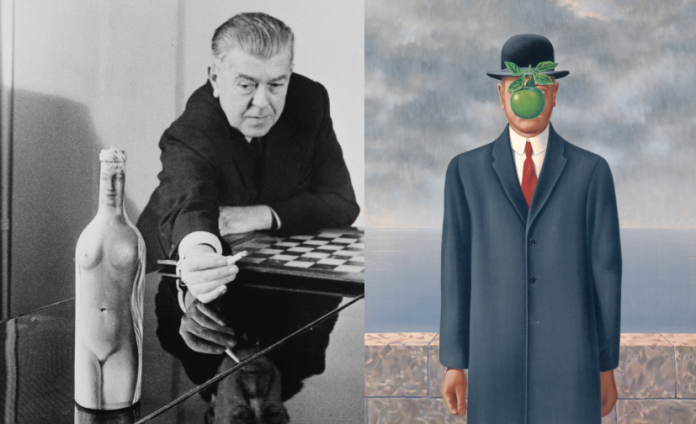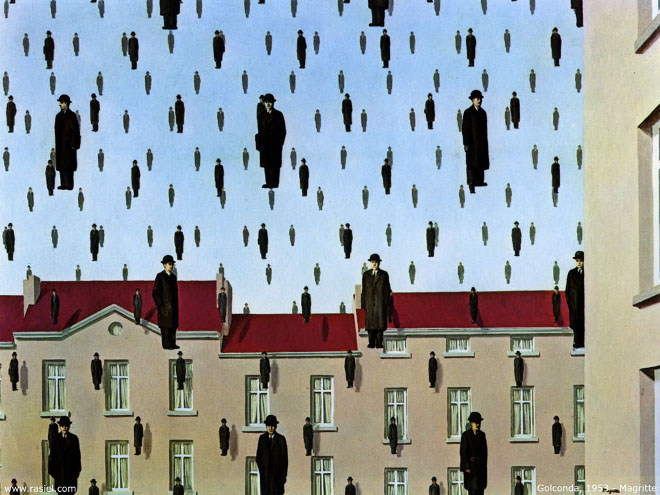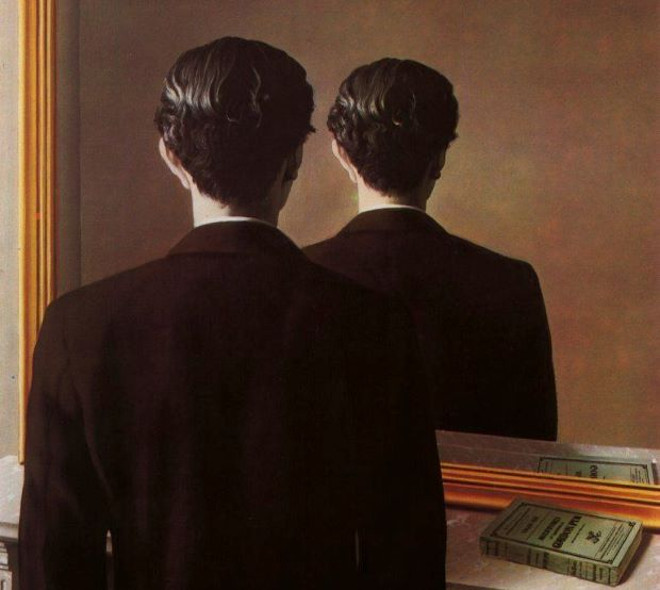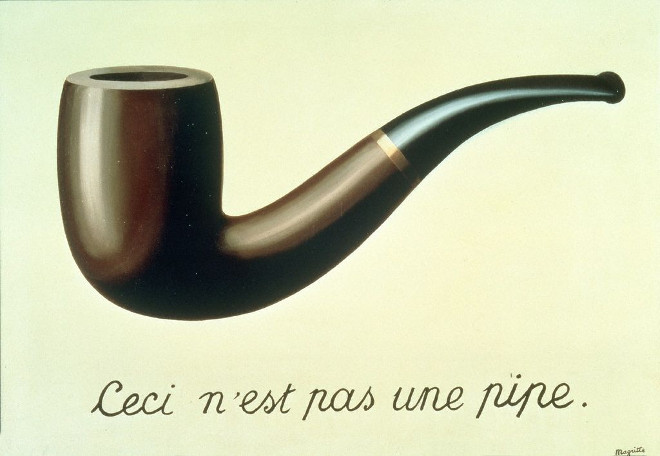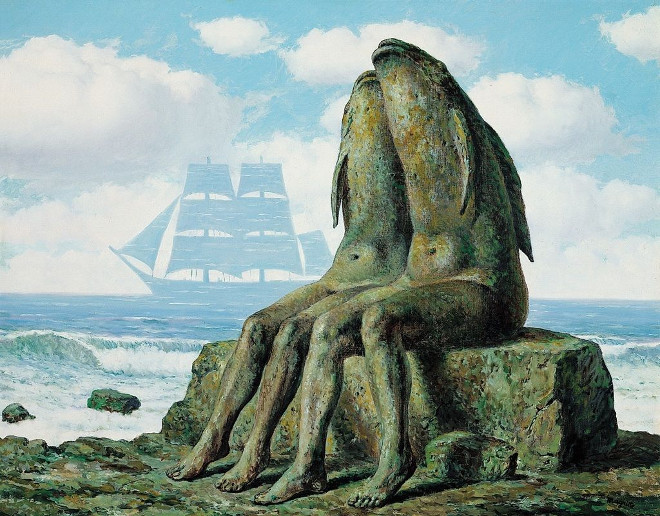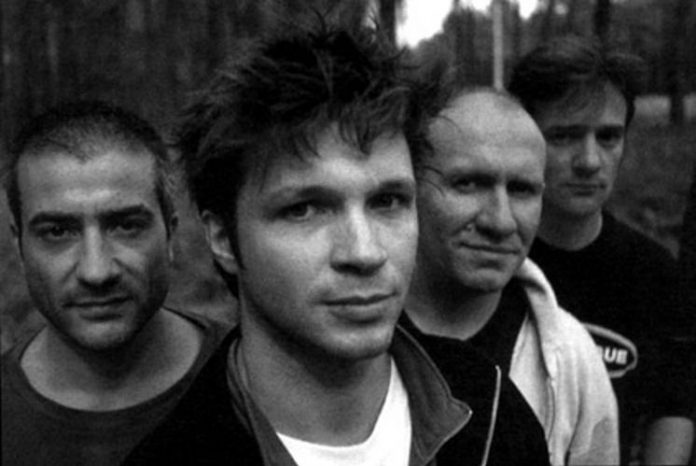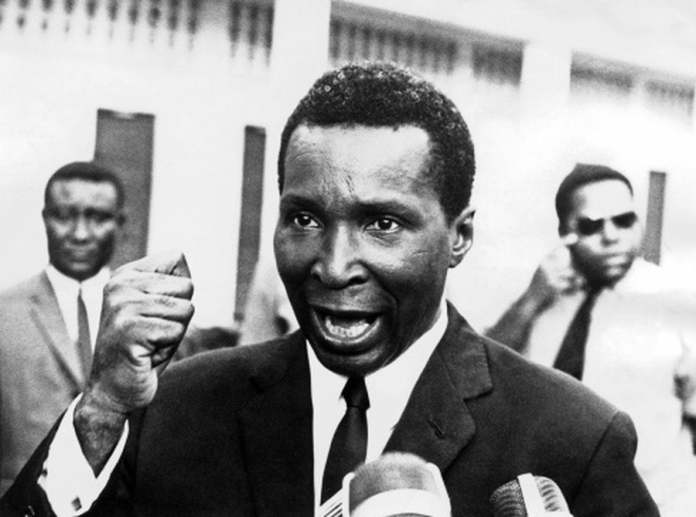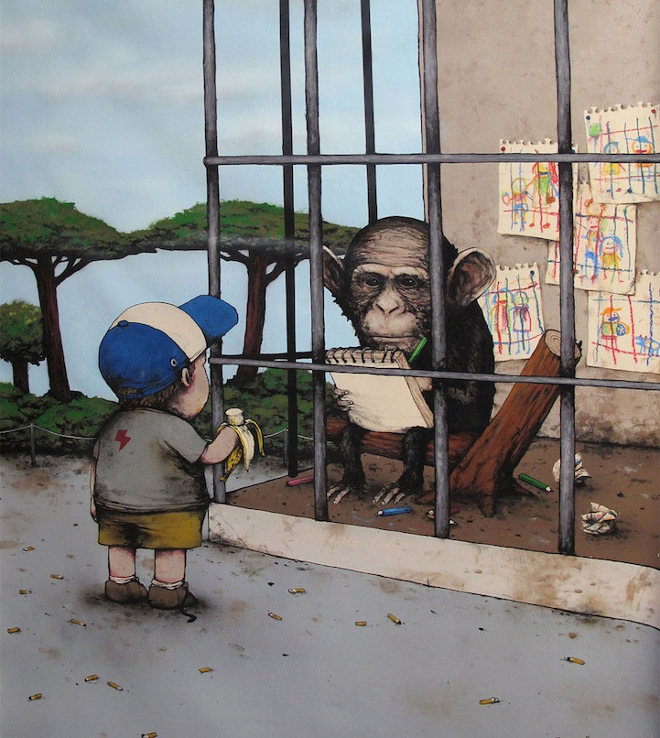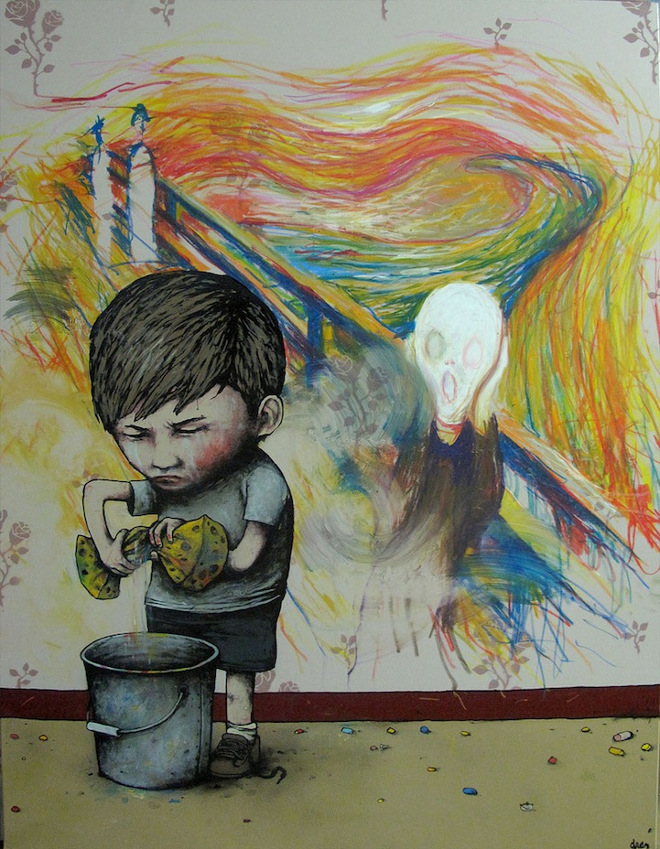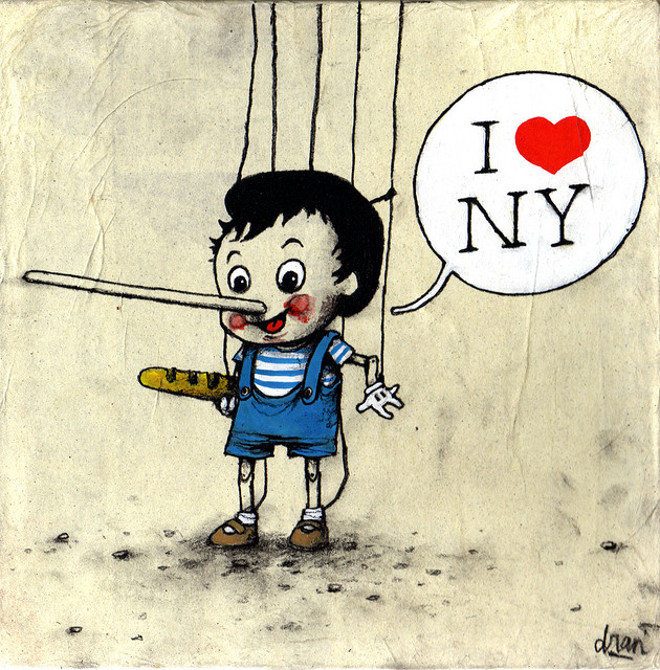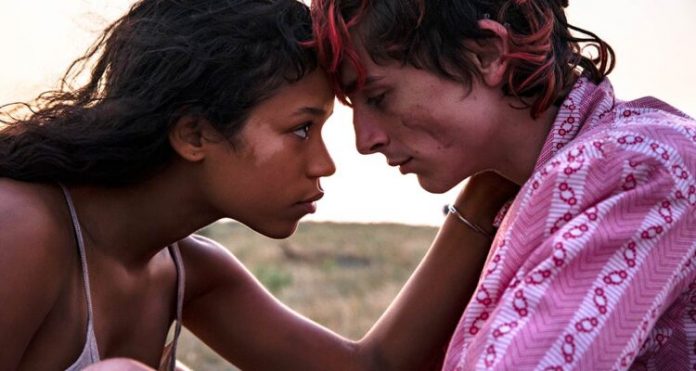200+ frozen bodies on Everest slope
Hundreds of people try to climb Everest every year. 4,000 daredevils have successfully made it, but hundreds of climbers have never reached their ultimate destination—the top. To reach it, climbers have to climb in incredibly difficult weather conditions, endure temperature changes and low atmospheric pressure, and negotiate the treacherous mountain, passing through the ominously named “death zone”.
Mount Everest is the highest point on the planet, 8 848 meters above sea level. Everest is located in the Himalayas, on the border between China and Nepal.
At the top of Mount Everest in China, there are strong winds, sometimes reaching speeds of up to 200 km/h, and air temperatures dropping to -60 °C. There is a “death zone” at the top of the mountain.
Here, oxygen levels are insufficient for human life. In the “death zone”, the human body cannot acclimate and uses oxygen faster than it can be refilled.
Without timely action and replenishment of oxygen reserves, the functions of the human body can deteriorate, leading to unconsciousness and eventual death.
Everest has seen people of all nationalities perish, from seasoned climbers to novices. However, not everyone recognizes that those who meet a cruel fate are often left lying where they fall.
Everest itself has become a cemetery where bodies lie for years, some for decades. The reason for this is that it is too dangerous and difficult to try to remove the dead. Reaching the top of Everest is a physical challenge, and it would take too long to try to bring a corpse or a dead climber back down.
A rescue mission would be almost suicidal. Nevertheless, some experienced mountaineers have made efforts in recent years to bury climbers who have died in more accessible parts of the mountain.
Among other things, there is a part of the mountain known as the “Rainbow Valley” where dozens of dead climbers’ bodies are visible thanks to brightly colored climbing jackets. Those who intend to climb to the top should be aware that they may not return from the trip.
Climbing a mountain is not entirely up to the individual. Hurricane winds, icy oxygen valves, poor timing, avalanches, exhaustion, and similar factors can kill an experienced climber.
According to scientists, exhaustion, poor weather conditions, and avalanches are the most common causes of death for Everest climbers.
The first person to climb Everest was British mountaineer George Mallory. He was the first person to become a victim of Everest. In 1924, he and his group set off for the top of the mountain, but he became separated from his team at around 8,500 meters. 75 years passed before they discovered his body.
For many years, speculation surrounded whether he had indeed reached the top. It wasn’t until 1999 that they discovered his remains near the top of the mountain.
With a broken pelvis, George Mallory’s body lay as if he were heading for the top. Until his final moments, the British climber aimed to conquer the mountain of his dreams, but, unfortunately, he did not succeed.
The first person to climb Mount Everest was Edmund Hillary from New Zealand in 1953. Together with a mountain guide from Nepal, he reached the top. After them, daredevils from all over the world flocked to Everest, but they did not always triumph.
More than 200 people have died on Everest in the past 60 years. Climbers have not only lost their heads here because of injuries or fatigue, but often because of the reverence and indifference of those around them.
Jordan Romero, a 13-year-old American, is the youngest person to climb Everest. In May 2010, accompanied by his parents and three helpers, he reached the top of the world’s highest mountain, making him the youngest person in the world to climb Everest.
And Bahadur Sherchan, approaching his 77th birthday, is considered the oldest person to have climbed Mount Everest.
In 1996, Japanese climbers discovered three fellow Indians nearly frozen to death on their way up. The Japanese continued their journey upwards, and all the other Indians died shortly afterwards.
In 1998, Russian Sergei Arsentyev and his American wife Frances set off for Everest without oxygen tanks, but the mountain did not let them go. The couple got lost in a blizzard, and Sergei died while looking for his wife.
They didn’t discover his body until several years later. Francis passed several groups on her way down the mountain over two days, but they did not help her or feed her. The dying woman was rescued by another British couple, the Widholles, who abandoned their expedition and went in search of the climber.
Unfortunately, they were unable to help her, and the couple themselves nearly froze to death on the way back. A year later, the Widholles still achieved their goal and reached the top.
On the way up, they found Francis’s remains in the same place where they had left her the year before. They then saved money for another 8 years to return to Everest and bury Francis’ body.
The conquest of Mount Everest became a hotly debated topic in 2006. That year, the mountain witnessed a shocking event that garnered global attention and discussion. 42 people passed by David Sharpe, who was dying of oxygen deprivation.
Among them were journalists from the “Discovery” TV channel, who asked Sharp a few questions, gave him oxygen, and left him alone. The other person to leave Sharp to his fate was disabled climber Mark Inglis, who was in the middle of an unprecedented climb with a prosthetic leg.
He had no intention of abandoning his glorious climb for the dying man, so he continued. Inglis managed to reach the top and became a hero, but he did not help his dying colleague.
Perhaps the most “famous” body that never reached the top of Everest is the so-called “green shoes”. This nickname was given to the unidentified corpse of a climber who became the main feature of the North Ridge route on Everest.
The term “green” shoes originates from the footwear still worn by the deceased person’s body. All expeditions from the north encounter a body lying in a cave. David Sharp died in the same cave.
Mount Everest is a beautiful but very dangerous place, so reaching the top is an incredible success. However, the bodies that mark the path to the top are a cruel reminder of the price that can be paid for climbing the mountain.
Yet in the last decade, thanks to technology, climbing Everest has become much safer. Satellite phone connections allow climbers to communicate with the base camp, receive constant weather updates, and keep in touch.
The overall death rate on Everest over the past 56 years has been 9%, but since 2004, this has fallen to around 4.4%.
“Burning Man” festival in the USA desert: freedom to be yourself and give without expecting a reward
For over 30 years, the “Burning Man” festival, which takes place every August in the Black Rock Desert in Nevada, USA, has attracted around 70 000 participants from all over the world, including at least 10% of Europeans.
Starting as a movement of a handful of freelance artists, this cultural phenomenon has evolved into the “Burning Man Project”, a non-governmental organization founded in 2014 with a big ambition and a broad vision—not only to bring people together for a week to form a free, non-monetised community, but also to spread the philosophy and values of the “Burning Man Project” around the world.

The main idea behind the festival is giving. Giving is not only about material goods but also about giving your time, attention, care, and friendship.
You can actively grant favors. Participants in the festival say that this event is an example of how not everything is based on money.

According to the organizers, “Burning Man” is not just a once-a-year festival; it is a community that shares the same values. Many even call this project utopian. It is a utopia that exists in reality but only lasts nine days.
Perhaps the organizers were realistic in their assessment that it could only exist in the diaspora and only for a certain period of time.

The participants themselves organize everything that happens at the festival. Participation is another of the ten key principles of the movement.
Some, of course, come as observers at the beginning, but in the end they all claim that it is not enough for them to take – every now and then they also want to give.
There are even people from professions such as aerospace engineers and physicists, scientists who study sperm, circus performers, and ordinary people who mend shoes or bicycles. They all have something to offer others.
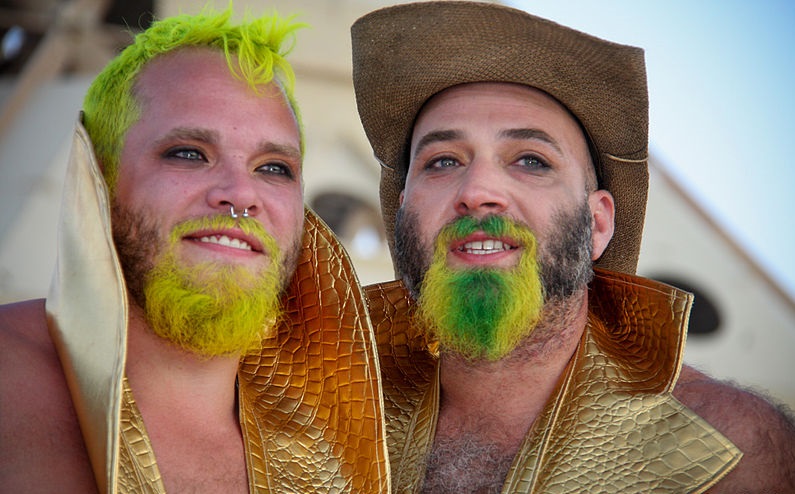
Each participant is also ready to provide a spectacle for those around them, with unusual costumes performing in the streets, bicycle decorations glittering on every corner, futuristic cars cruising by with music blasting from the speakers and people dancing on top of them, all covered in dust. It’s like something out of a “Mad Max” movie.

So, as you can see, all the exchanges that take place during the festival are based on goodwill. Even the food is free. There are usually different campsites in the towns where the party-weary participants can feel like a family and cook together.

Often it is a gathering of different nationalities, all serving their national dishes. Apart from family gatherings, the festival is also famous for its parties, which take place after nightfall.

On the other hand, there’s more than just cooking and partying in the vast area of the town. Everything from lectures to choir performances can be found.
According to the participants, it is impossible to see and try everything. 70,000 people, all presenting their skills and gifts, is no joke.

The town goes by the name “Black Rock” and holds the title of the world’s largest temporary city. It has everything you would find in an ordinary city: streets, hospital, post office, police and fire stations, etc. Most people are advised to bring their bicycles, as this is the best way to cover long distances to reach the various sites.

The art installations alone take up a lot of space. And of course, there are so many of them that it’s impossible to see them all, and they are created by artists from all over the world. Interestingly, on the last Saturday of the festival, most of these installations are burned.

So many hours of work goes to ashes. But this solution is very reminiscent of the principle of performance art, where the process is the most important thing, not the art object. This phenomenon also has a symbolic meaning.
Burning the objects teaches the participants not to form attachments to them. Meaning that the experience is more important than the objects.

During the same Saturday, they set on fire a symbolic wooden statue of a man. And this exact ritual was what inspired the name of the festival.

Another of the “Burning Man” principles is unconditional acceptance of others: everyone involved has the right to express themselves in any way they want, provided they do not hurt anyone.
It is the freedom to be yourself and by being yourself, to find like-minded people and make lifelong friendships.

However, there are some challenges. Everyone must actively prepare to endure in the desert. No help is provided. So the aim is not just to give and show yourself, but to survive in the desert in a nature-friendly way.

At the end of the festival, leaving not a single piece of trash is a requirement, and participants arrive with massive mobile homes – campers – equipped with water, food, clothing, tools, and other necessities for nine days.
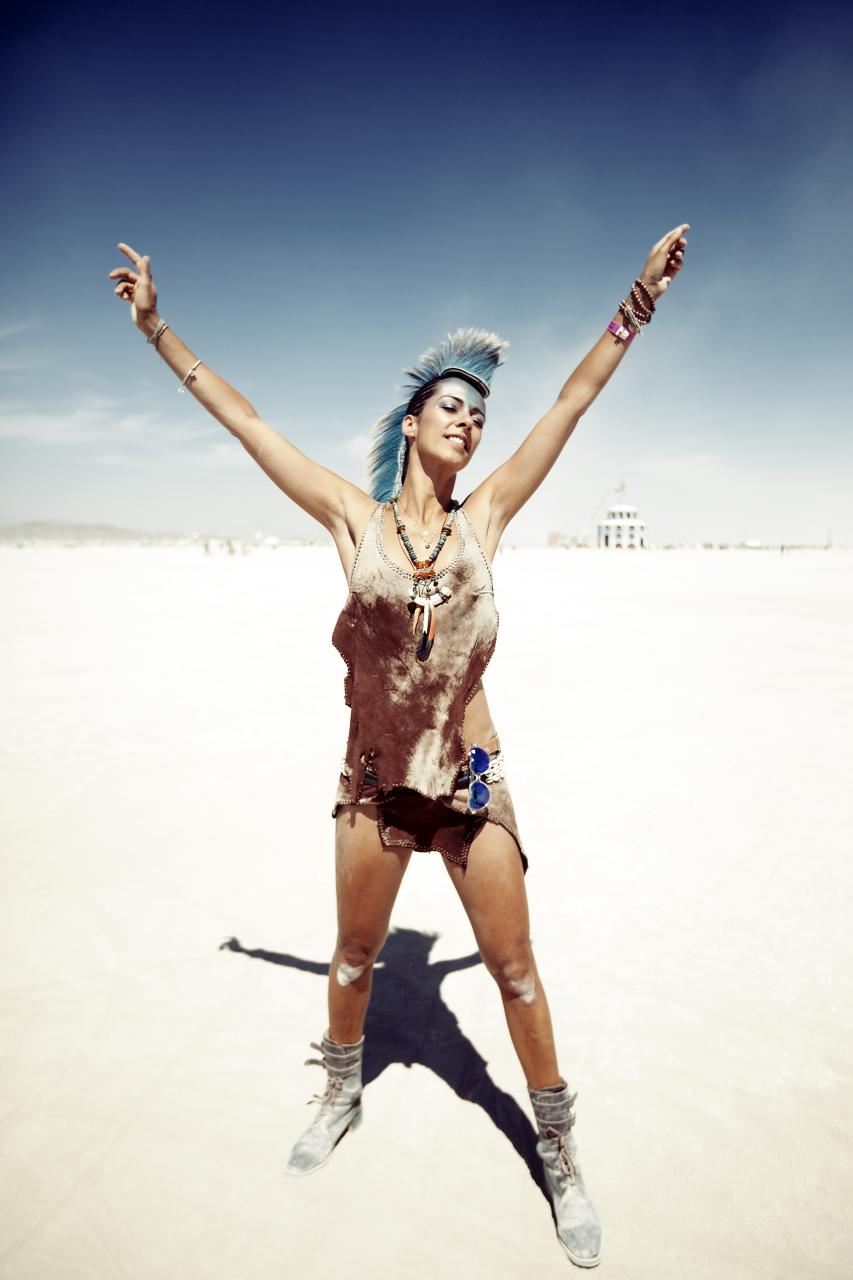
As you might expect, while everything is free during the festival, the preparation itself is an expensive affair, costing anywhere from $1,300 to $20,000, including food, transport, camping fees, costumes and gifts. And the ticket itself costs money. Typically, the price ranges from 425 to 1 400 dollars.

Scientists are also interested in the “Burning Man” movement. Research has been carried out from religious, art historical, sociological, psychological, cultural geography, anthropological, architectural and marketing perspectives.
It has been observed that the culture of giving and sharing has given the participants in the movement the connotation of pilgrims and worshippers, instead of being perceived as mere observers, consumers, gamblers.

Take a look at the festival through the eyes of Ukrainian traveller Anton Ptuskin.
If “Burning Man” had to be shortly defined, it would be a global cultural movement based on ten principles, most of which have been listed in this article.
It has reached not only over 30 states in the USA, but also countries such as Canada, Spain, France, Sweden, South Africa, New Zealand, Australia and Israel.
Similar festivals have been launched in Lithuania, with the same freedom of expression and 10 principles.
10 music videos where women objectify men
Displaying and freely disposing of women’s and men’s sexy bodies has become an integral part of music videos and one of the main features of the music industry, which tries to convey it in a variety of ways, from naked girls wearing bikinis to half-naked men showing off their sexy, muscular bodies. It’s true that music videos are most often male-dominated, with naked women’s bodies side-by-side as if they’re just an ornament to the music video, pulsating with passion, sexuality and eye-catching appeal, but we’re going to give you 10 music videos in which women are objectifying men, and are becoming the real masters of the situation.
Elle King – Ex‘s & Oh’s
The music video starts with a little intrigue – a woman drops off her ex in the middle of the desert and just drives on. In the next episode, the singer is in the desert surrounded by the hottest half-naked guys who are trying to do anything to get her attention, even if it requires more effort. The images are not without sexual metaphors – the food is shown, symbolising the woman’s desire to “eat” the men and all those troublesome relationships. The lyrics describe ex-boyfriends as ghosts who always appear and want to come back to haunt her, as the guy who gets out of the car at the end of the video eventually does. Throughout the music video, the woman is portrayed as dominant and in control, but the sexuality of the woman is not emphasised, on the contrary, the guys become the main symbol of sexuality, showing off their beautiful bodies and fulfilling all the woman’s whims, fighting for the attention of the only woman. However, this music video has been noticed and appreciated by critics, who say that we are used to seeing the objectification of women in modern music videos, and this role reversal shows that the opposite can be true.
Kelly Rowland (ft. Big Sean) – Lay It On Me
In this music video, sexual attraction is conveyed through bodily prowess, movements, touch, and the open display of athletic male bodies. It depicts feminine charm, which is displayed by a number of attractive dancing men who convey the perception of the woman as a kind of “goddess” (scene where the men hold the performer on their back / the man holds up the woman’s body with his own hands), which becomes the main expression of the musical text, reflecting the words of the text. The clip also conveys a close feminine relationship with the male sex, but maintains an aesthetic boundary in which the depiction of a woman’s movements and touches in relation to men is only an example of the attention to be sought.
Marina and The Diamonds – How To Be A Heartbreaker
Just hearing the title “How To Be A Heartbreaker”, it would be hard to imagine the video without a lot of charming guys and of course the main girl. The video for the song shows a girl in several different spaces, none of which she is real as a person when she is with guys. This is symbolised by the different coloured hair accessory, and the lyrics convey the idea that the girl is afraid of being hurt, so she chooses to be a heartbreaker herself as a defence. The first location of the music video is a very revealing one – a guys’ shower, where a bunch of guys stand under a running shower stream, showing off their athletic bodies. All the guys in the video draw attention with their very intriguing and sexy bodies. Here, roles are reversed and the girl becomes the heartbreaker, while the guys find it hard to resist the feminine charms.
Jennifer Lopez ft. French Montana – I Luh Ya Papi
The music video, filmed in Miami, Florida, reveals men’s shapely bodies. The video aims to show that it is not only women and women’s bodies in the music industry that can be shown as sexy, open and provocative, but that women also have the power to objectify men. This video has received positive critical acclaim and recognition because the perception in the music industry is that women should mostly show an open, sexy body, which is perceived as a necessary tool, but by trying to look the other way and showing the opposite sex in this kind of music video, it is clear that women also have the ability to control, and the talk of sexism in the music industry can be refuted by such a music video.
Charli XCX – Boys
The music video for the song “Boys” hit the charts in just one day. The clip shows a lot of completely different boys doing different but ordinary things (e.g. cycling, reading a book, brushing their teeth). As women are very often shown in different contexts, this video is an attempt to show and portray men as characters that are mostly fulfilled by women. The men are chosen from different parts of the world, with different favourite music genres, different hairstyles, figures and outfits. An attempt to convey a different view of the body in general, which is already established as necessarily sexy and attractive – especially the body that women have to portray in music videos – but this video is not afraid to show different bodies and a different perception of it.
Katy Perry – Wide Awake
Although this music video doesn’t feature naked bodies and sexy dancing, it shows the relationship between a woman and a man in a slightly different way. The video itself takes us back to the singer’s childhood, which is full of moments of hardship and experience. The scene in which the woman meets the prince on horseback, and when he approaches, she strikes him in the face and he “flies away”, seems a bit unexpected for the viewer, but it is a way of showing the strength of a woman’s personality, in this case with the chosen motive. We probably could not imagine a reversal of gender roles here. But it’s not so easy to resist every woman’s dream of a prince.
Meghan Trainor – Dear Future Husband
It is a music video that has been met with critical backlash and double reactions. Some are outraged because they feel that the video overly depicts stereotypical gender differences and takes us back to the 1950s, where this was strongly felt, which is not the case in modern music videos. It doesn’t shy away from showing scenes of a woman doing housework, and on dates showing men trying to please her and show her attention and impress her in all sorts of ways, but she rejects all the guys and doesn’t like any of them because of all sorts of little things that are not done right. The dominant image of the woman is shown, she “chooses” the guys, she becomes the mistress of the date.
Fifth Harmony – Work from Home
The music video features five charming girls in an unusual construction environment, surrounded by muscular construction workers. The men are all shown bare-chested, emphasising the sexuality of the male body, which is at the same time conveyed through the masculine work. As the director of the music video himself says, this video conveys a different version and approach to gender roles, where men, unusually, become the objects and women maintain and coordinate the whole environment. The role of the girls in the video is to distract the guys from their work with seductive dances, body movements, facial expressions and touches, while at the same time creating a light flirtation between men and women.
Bebe Rexha – Baby, I’m Jealous
A song about fighting jealousy, the negative influence of social media and society’s expectations of the female body. The athletic male body is also used, which is very openly displayed next to a woman in the wild, obviously such a provocative representation of a man is treated as a sexualised object in the video, and the touching of the bodies demonstrates open seduction. Although a lot of attention is paid to the beauty of women, and the heroines of the clips are characterised by their perfect body lines and become a real attribute of beauty, the lyrics of the song try to convey the message that it is not necessary to be conformed to another’s body.
Billie Eilish – Bad Guy
The ending of the music video is exceptional and may seem a bit sinful. It turns out to be a girl sitting on a guy’s back in a dark, red room, doing push-ups. The athletic body emphasised by the guy at the end of the music clip, which is also indicated by the act of leaning back, is notable. The girl sitting on the guy’s body seems to take a higher position, in which the guy is assumed to be willing to submit to the girl.
Bertrand Cantat and “Noir Desir”, or how a rock band at the height of its powers was broken up by a murder in Vilnius
The musical achievements of the French rock band “Noir Desir”, which rose to prominence in the 1980s, have been overshadowed by the echoes of the murder committed by the band’s singer, Bertrand Cantat, in Vilnius.
The road to the stars
Bertrand Cantat, the son of a military man and a former primary school teacher, was born on 5th March 1964, and lived in Pau with his brother Xavier and sister Ann, before moving to Bordeaux.
Bertrand, who wrote the lyrics, became friends at school with Serge Teyssot-Gay, a 17-year-old guitarist, and decided to form a band because of their shared love of bands such as “Led Zeppelin” and “The Who”. Bertrand Cantat chose to be the vocalist and Serge Teyssot-Gay the guitarist. Then they met Denis Barthe (on drums) and Frédéric Vidalenc (on bass guitar) and started performing locally. 1980-1985 can be considered the formative period of “Noir Desir”, the name of which gradually changed from “Psychoz” to “Noirs Desirs”.
As the band searches for a record label to sign them, “Noirs Desirs” abandons the plural form of the names of rock bands from the 70s and 80s, and with their mini-album “Où veux tu qu’je r’garde?” became a success and secured a place on “Barclay Records”. In 1989, the band achieved its greatest success with the album “Veuillez rendre l’âme (à qui elle appartient)”, which was hailed as one of the best French rock albums ever made. Bertrand Cantat, often referred to as the French Jim Morrison, and his band became one of the most important figures in French music history with the albums “Aux sombres héros de l’amer” (1989), “Du ciment sous les plaines” (1991), “Tostaky” (1992) and “Dies irae” (1994).
The 1990s and disasters.
The band performed at full volume and attracted international attention, but things started to change in the 1990s: after a concert in Besançon in 1991, Cantat and the band were unable to continue their tour due to health problems, and in 1994 the vocalist had to undergo surgery on his vocal cords. The band took a break and Frédéric Vidalenc left the band to pursue his personal projects. In the 1990s, the vocalist’s meeting with the women of his life was also a defining moment in the band’s destiny.
Vocalist’s first marriage and relationship with Marie Trintignant
In 1993 Cantat met his future wife Christina Rady, whom he married in 1997. Cantat had two children with her: a son in 1998 and a daughter in 2002. In 2002, through his sister, the singer meets Marie Trintignant, a famous French actress, with whom he begins an affair one month after the birth of his daughter. According to him, Christine was depressed after giving birth and he tried to take care of the children as best he could.
Bertrand left his first wife, Christine Rady, to live with Marie Trintignant, and in 2003 officially divorced her. Marie Trintignant was a famous French actress who had four children from her previous marriages, three of whom were cared for by her ex-husband. Both Marie and Bertran were very emotional and jealous people who did not want the other to have any contact with their ex-spouses, which eventually led to the tragedy that occurred in Vilnius on the 26th of July 2003, after a party, when the actress was beaten up and slipped into a coma, from which she did not recover.
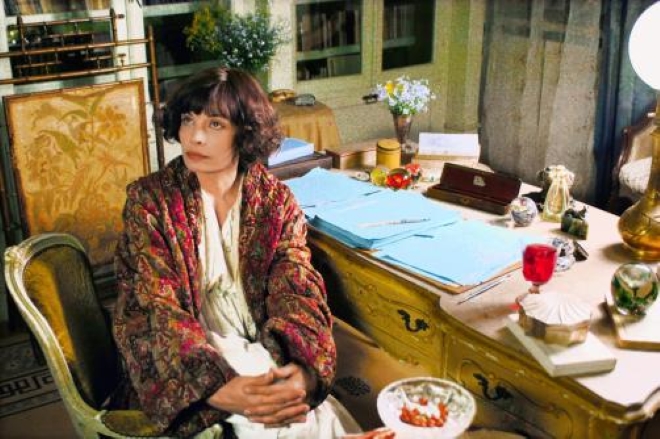
Murder of Marie Trintignant
Marie and her family came to Lithuania for the filming of the TV series “Colette”. Her husband Cantat accompanied her and watched her on the set. According to film producer R. Urbonas, “They walked holding their hands. Everything seemed very nice”, but everything changed after one party, during which they had too much alcohol. Marie showed Cantat a text message from her ex-husband. The tragedy took place at one of the hotels in Vilnius. He saw her ex’s tender words to her – “Thank you, my dear Janis” – which had been concealed before. The singer was then furious at the unequal conditions – they had both agreed not to be friendly with their exes. He claimed that he “did not recognize Marie”, that she was “malicious” and that her words were “abusive”. Finally, in a fit of rage, Cantat became violent and beat Marie to the point where she ended up in a coma. In the morning, an ambulance was called for the beaten actress, but she did not survive due to severe head injuries.
The punishment
In court, Cantat was faithfully and without condemnation supported by his ex-wife, Kristina Rady, who said that she had never experienced violence in her relationship with the singer. The singer said in court that he thought she was just sleeping, so when he realized that she was breathing, he simply put her to bed. Cantat was convicted in court of “intentional violence resulting in death without intent to kill” and “failure to render aid to a person in danger” for 8 years, but his good behavior led to his early parole in 2007. In July 2010, Cantat’s parole conditions ended and he became free again.
Life after sentence
After Marie’s death, he was in a difficult psychological state, had to take antidepressants, and, according to his lawyer, said he wanted to commit suicide. He eventually sought professional psychological help and got better, but the blows in his life were not over: in January 2010, his ex-wife and mother of two, K. Rady, who had supported Cantat in court, committed suicide in her home. Of course, the singer was criticized for this, and his influence on his ex-wife’s death was investigated, but no evidence was found.
Group separation
In 2010, his band “Noir Desir”, which he had been allowed to contribute to during his time in prison, finally split up. Since then, the singer has been working on his music under the radar, his career has been accompanied by feminist outrage and accusations of violence and provocation.
Guinea’s dictator – a man whose decisions resemble those of a psychopath
Equatorial Guinea – one of the richest countries in Africa. At one time, it was the richest, thanks to the oil resources found in its territory. Its first president, Francisco Macias, a hardened dictator, held power with his fist tightly clenched for 11 years, until 1979, when he was overthrown. But how brutal and how much does one have to torture a nation to make it rebel?
He was born in 1924 in colonial Guinea, which was part of the Spanish colony. It was the only Spanish colonial state in sub-Saharan Africa. The dictator is said to have witnessed the death of his father when he was nine years old. He was beaten to death by a Spanish colonial policeman. The day after the incident, his mother committed suicide out of grief. It can be assumed that these shocking events early in his life had a direct impact on the then young Nguema. Perhaps that is why the man became such a cold-blooded individual who sought power at any cost, perhaps always through violence.
How did a man of such brutal character get elected as President? During his campaign, he manipulated the masses and told them what they wanted to hear, and he was not afraid of harsh and rhetorical nationalistic views. That is one of the reasons why he won against another candidate.
He has only completed primary school. He could read with syllables, but not write. The man even crossed himself three times in the civil service exam, which led to a low sense of self-esteem that turned into hatred of intellectuals.
Politically, he became known for his ardent support for the Spanish colonists. He made his way into local government at the fourth attempt, launching his political career. Nguema Mongomo was mayor of the town during the period of Spanish settlement.
Later, he was a member of the local parliament. Before the country declared independence in 1968, Nguema was elected President in the only democratic two-round election in the country’s history. The man immediately began to physically eliminate or kill his opponents.
Bonifacio Ondo Edu, a former Prime Minister who also ran for the presidency, was starved and died in prison just after Nguema became President. Another version is that Edu fled the country after the unsuccessful elections and later committed suicide. Finally, a third speculation is that Ondo planned a rebellion against Nguema after the failed elections, and that Bonifacio was executed when this was revealed.
During this period, other former high-ranking officials of the country were officially recognised as having committed suicide, although many believe they suffered the same fate as Edu. All opponents are known to have been cracked down on and their assets confiscated, sold or otherwise appropriated and exploited. But such things require a repressive structure. A national militia was formed under the name ‘Youth in March With Macias’.
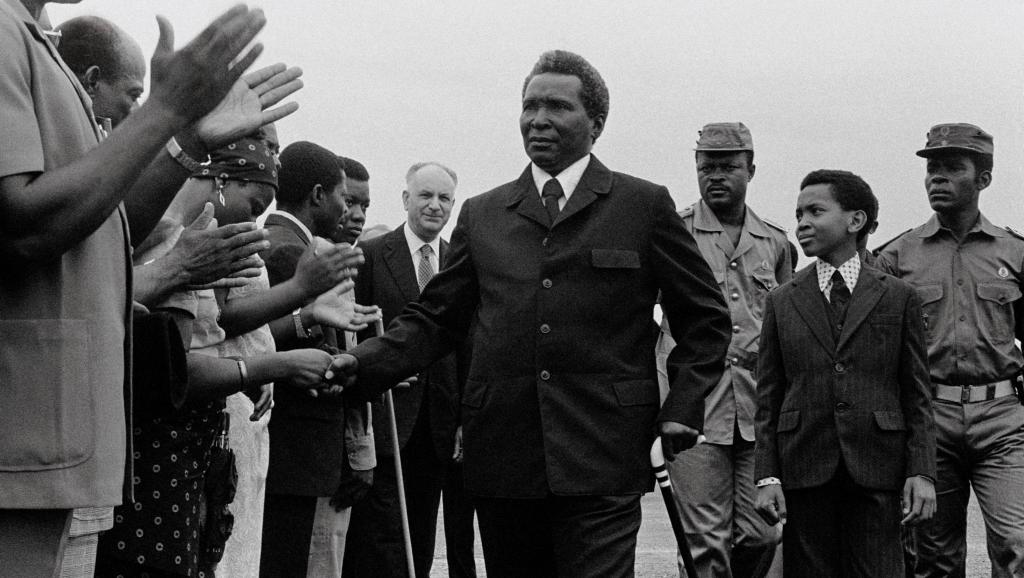
This structure was the dictator’s main weapon against the people. It was they who carried out all the whims of the ruler and are responsible for the mass extermination of civilians, torture, looting and the burning of entire villages.
Attacking objects such as plantations was not frowned upon. One example is the destruction of a cocoa plantation set up and worked by Nigerian migrants. The workers there went on strike and demanded higher wages, as the taxes were enormous. In addition, these personal thugs also beat up Nigerian diplomats when they arrived in the Guinea capital.
Perhaps the most notorious case of mass murder took place on Christmas Eve, 1969. 150 political opponents were lined up in a stadium and shot. Cold-bloodedly, the officers who carried out this crime were wearing Santa Claus outfits and the sound system was playing the song ‘Those Were The Days My Friend’ by Mary Hopkin. That same evening, the 26 victims were ordered to dig a trench in which they were later buried up to their necks and left to their fate. More precisely, to be eaten by red ants.
Francisco was extremely jealous and ordered the murder of all his mistress’s former admirers. In addition, all the men of his personal sympathies were killed.
It is estimated that around 80 000 people were killed during Nguema’s reign. This is an insanely high figure, given that the country had a population of around 600 000 people at the time. Nguema’s human rights abuses resulted in the emigration of more than a third of the country’s population to other countries.
The dictator ordered the dismantling of the railway to prevent people from leaving the country. All the instruments of oppression (military, personal guards) were under the control of Nguema or the people around him.
However, absolute power was not yet officially in the hands of a man, so he went even further. On 7 May 1971, a new declaration was issued which partially revoked part of the 1968 constitution and gave Nguema unlimited power: areas that had previously been the responsibility of ministers, the government or other municipal institutions became the direct presidential responsibility. In the same year, another regulation was issued: threatening the President or the government was punishable by death. Insulting the President or his cabinet of ministers was punishable with 30 years in prison.
A year later, another bold step was taken. All the country’s former parties were merged into a single party, The United National Party. Of course, it was led by Macias. In the country’s Parliament, the man had personally held 20 of the 60 seats and half of the posts in the government.
This was followed by the implicit law: the President remains in office for life. The government was the victim of family scandals, with many ministers being trusted confidants from the same village as the President. Nguema appointed his nephew as head of the National Guard.
The government also took over the economy. Of course, the President had no idea how the economy worked, nor how to strengthen the currency. There was not even a system for the distribution of funds so that all the tax money could be distributed efficiently. Nguema managed to assassinate the head of the country’s central bank and declare that only the President of the country could reliably maintain the gold and currency reserves and then he took it all for himself and kept the assets, first in his villa, in his bedroom, but later he found this to be too unreliable so he took seven suitcases of money back to his home village. Since the money was buried under the ground, some of it rotted.
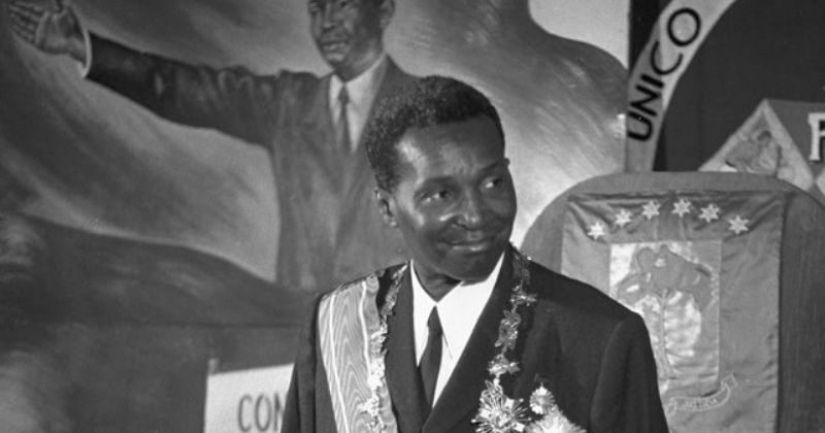
Macias proclaimed himself the genius of science, education and culture, thus launching a war against all intellectuals. He claimed that the educated social class was polluting the political climate of the country with foreign cultures. Almost all educated people were killed or exiled. Private education was declared ” destructive ” and was banned. The word “intellectual” became a complete ban.
It seems silly, but wearing glasses has been banned because, according to the President, this is how intellectuals try to pretend to be smarter than everyone else.
“I’m not a fool myself, even though I’m from the peasantry, but they put on glasses to show off to working people.”
Over time, Francisco has become overwhelmed by his power and has started to make strange choices. He used his own indigenous knowledge of shamanism to frighten the population in order to further justify his rule. This was followed by even more absurd actions, such as burning boats for fishing and booby-trapping roads to prevent people from fleeing. Finally, economically, the country stagnated: 90% of public services, such as electricity, the post office and transport came to a complete stop. The cocoa and fishing industries, which had sustained the economy up to that point, also crashed. As if all this were not enough, the President also banned western medicines.
Of course, Macias himself could not govern without electricity, so when the country’s electricity economy began to collapse, he declared that electricity was not necessary and cut off everyone’s power, using generators to get electricity in his palace.
You would think it couldn’t get any stranger, but the dictator banned the Catholic Church and declared himself a god. He did not use alcohol, but abused psychotropic drugs very often. Some believed that the dictator’s behavior was due to his heavy and frequent use of marijuana.
Eventually, he needed a doctor, but it turned out that there were no doctors left in the country. His relatives then called in a doctor from Cameroon, who was shot dead after examining the dictator. Some people in the President’s inner circle have speculated that he may have become a psychopath as a result of childhood trauma. Other psychological conditions were also said to have influenced his actions.

Fortunately, everything comes to an end. And so it is for the dictator of Guinea. Many dictators have been famous for their bizarre or extravagant decisions, but one thing is clear: you can afford to do a lot of things when you are in absolute power until the military is satisfied. This is where Nguema made the critical mistake of not paying the promised wages to the military.
On 3 August 1979, he was forcefully overthrown by his own nephew, Teodoro Obiang Nguema Mbasogo, who was the head of the country’s National Guard. The whole process has been described as an execution.
Teodoro felt obliged to rebel because in 1979 there was an incident in which 6 soldiers of the National Guard went to the capital of Mongolmo and demanded the wages that were rightfully theirs for the work they had done, however impossible it might be. Six soldiers were killed. This was a kind of signal to the nephew that the uncle had ‘got too much in’ and that it was time to take over. The best defense is offense.
Mbasogo and part of the army managed to catch Nguema on 18 August in the country’s jungle with an empty suitcase containing money. He is believed to have eaten about 2 million dollars during his two weeks in hiding, and burnt some of it to keep himself warm. Other sources claim that the President was arrested in his home village.
The fury of the National Guard was justified. Over the course of his 11 years in office, the President owed them between $20,000 and $50,000. In a special court martial, Macias was accused of genocide, mass murder, theft of public funds, human rights violations and stealing.
The court sentenced Nguema to death and on the 29th of September of the same year he was executed. His nephew took over the presidency and has been in charge ever since.
Tender is the Flesh – a provocative dystopia by Agustina Bazterrica
The book focuses on sensitive and latest issues today. Literary critics have praised the novel as capable of exposing many of the entrenched conspiracy theories and the worst features of hierarchical capitalism. A dystopia that is uncomfortable and disturbing but gripping from the very first page. A book that will be relevant for a long time to come, as the dystopian genre becomes increasingly popular.
Argentinian writer Agustina Bazterrica has won numerous prestigious awards and literary prizes for her outstanding work. One of the most significant awards is the Premio Clarin Novela (Spanish literature prize), which she received in 2017 for her novel Tender is the Flesh (original title: Cadáver Exquisito). The book was published in 2017 but was translated into Lithuanian and published by Sofoklis in 2022 (translated from Spanish by Augustė Čebelytė-Matulevičienė).
Considered Orwellian, it will appeal to fans of George Orwell’s work, who understand that art is meant to shock and to evoke not only positive emotions, but also to make you think that sometimes what seems completely impossible can be quite possible. Before starting to write this book the author Agustina Bazterrica spent about half a year doing research, with a particular interest in the working principles of refrigerators for storing meat, animal rights and, of course, cannibalism. The author says of this novel, which is somewhat unique and not typical of her writing style: “For me, the style of each work is an additional means of conveying the message, in the novel Tender is the Flesh, the dry, almost sterile language is, in my opinion, more intimidating to the reader than a more complex expression would be. There have been people who have returned the book to bookshops because they were nauseous and had nightmares… I mention all this in the novel, but I don’t go into it too much, and I do it deliberately, to get an active reader. The novel is full of ambiguities, and I want the reader to resolve them.” Therefore, you can see that with this novel, the author was not trying to fascinate the readers, but rather to shock them and make them think and reflect on the possible future of humanity. While many people are currently enjoying the smartest technologies and thinking about the innovations and progress that await them in the future, the author opens their eyes and makes them see things from a different prism, and emphasizes completely different things like how far can humanity go?
Reading this book makes you realize that reality may not be so pleasant and cozy. It is about the future world whose predictions are not at all cheerful, but rather thought-provoking. The government’s attempt to control society by announcing a virus that is believed to be fictitious is just a way of reducing the supposedly increased human population. The media have begun to talk incessantly about the Transition, a process that has completely changed not only lifestyles and forms of farming, but also morals, beliefs, and humanity itself. The manipulation of people, which is causing division in society, that you cannot eat livestock, but trying to convince people that you can eat people, shows that it is not so difficult to influence society. This is relevant in today’s context as well. The intimidation of the people is so strong that it makes everyone think that eating animal flesh can kill them, because of that all kinds of animals are being slaughtered. And the emergence of a system in which the privileged begin to decide who can become edible human beings.
The novel is centered on the protagonist Marcos Tejo, who is faced with life’s challenges – divorce from his wife, the death of his son, an illness that is slowly destroying his father, who lives in a shelter but tries to devote a lot of attention and care to him, and his job in a meat factory. More precisely, in the slaughterhouse, where he works as a manager, slaughtering not animals but people, a job that not only gives the protagonist no satisfaction, but also makes him sick, a clear reference to capitalism. The author inserts that she “would like to say right here that for me they are not people, but products. They have no identity, no name. Hence, there is a difference in the novel between people and products for food.” Marcos tries to present himself as different from everybody else, with all his complex life experiences, still trying to follow common sense, but this does not justify the nature of his work.
The feelings of the protagonist of the book are contrasted after receiving a gift of a purebred female who was bred in captivity, he ends up raising her for a short period of time in a barn. However, he soon brings her home and even starts having a baby with her. This shows that he, as an enemy of the system, that is currently prevailing in the world, is going to be punished and he is going to suffer retribution by ending up in a slaughterhouse, because that’s the system’s way of dealing with such people. It forbids reproduction, love, and care of animals meant for meat. The protagonist begins to question what is possible and what is not.
The book describes every process of human butchery in a very convincing way, great detail and tidbits, as if forcing the reader to experience it for themselves. Especially the products, the parts of the human body that are available for purchase and for eating. The fragmentation of people, the different perceptions and possibilities are also discussed. The culture of eating human beings is attempted to be presented as a completely normal and natural thing, with people losing their compassion and understanding of what is appropriate and what is not. Even for children this process is already a completely ordinary, unquestioned experience, and that lets the reader know that future generations won’t change. It represents a humanism in decline: not all human beings are fit for a normal, fulfilling life, not all will be seen as human beings, but as animals, as meat. A fine line is drawn that seems to call into question the fact that this is normal, but in the end it will disappear completely. An absolute brutality that will not be perceived as a bad thing.
The Lithuanian title of the novel Mes, gyvuliai (lit. We, animals), also conveys a certain idea. The comma helps to create a kind of separation between man and animal, which is presented as a common whole in the book. Humans replace animals, but it helps to understand that what is being described is not normal and should disturb the readers.
Tender is the Flesh is a novel that forces you to step out of your comfort zone, is a bit cruel, uncomfortable, frightening, but it makes you see the world through a different perspective. The only comforting thought is that this is a fictional story that hopefully will never come true.
“Arnold”: a new documentary about Arnold Schwarzenegger on Netflix
Global film phenomenon, politician and fitness guru Arnold Schwarzenegger returns to our screens with a new documentary entitled “Arnold”. This exclusive multi-part documentary on Netflix takes viewers on a special journey through the life and career of the legendary actor.
The documentary “Arnold” surprises with unexpected interventions with Arnold Schwarzenegger himself, who tells his story from the early days of his life to the present day. The filming took place over a long period of time and the result is a gripping narrative of Arnold’s personal background, sporting career, cinematic triumphs and political activities.
Viewers will have the opportunity to see a unique behind-the-scenes look at Arnold’s transition from Hollywood star to influential Governor of the State of California. This is not only a documentary about one of cinema’s greatest figures, but also a glimpse into the secrets of success and wisdom that Arnold Schwarzenegger shares with his fans.

In addition to Arnold’s own recordings, the documentary will include interviews with his family, friends and colleagues. This will give a fuller picture of this iconic man’s life and what shaped him as an individual.
This documentary uses rare archive footage of Arnold’s youth, his sporting exploits and his greatest cinematic triumphs. These unique videos inspire and amaze, giving us a glimpse into the details of Arnold’s life career and the experience and wisdom he gained.

In addition to his film career, the documentary will also highlight Arnold’s political activities. After his acting career, he became involved in politics and even became Governor of the State of California in 2003. This Netflix documentary will explore Schwarzenegger’s decision to enter politics and his contribution to state governance.
The documentary “Arnold” will also deal with a subject that is very important to Arnold Schwarzenegger: the fight for environmental protection and climate change awareness. The documentary will shed light on his efforts to promote sustainability and create a livable environment, especially after he left politics. This area has become one of Arnold’s top priorities.

The documentary “Arnold” focuses on the most important aspects of Schwarzenegger’s life. From his outstanding athletic journey in bodybuilding, which helped him become a multiple Mr. Universe and Mr. Olympia champion, to his first step into the film industry, when he gained worldwide popularity for his roles in films such as “Terminator” and “Conan the Barbarian”.
In this unique documentary, Arnold Schwarzenegger reminds us that nothing is impossible and that the pursuit of goals and patience are key elements for success in life.
“IC3PEAK” is an experimental electronic duo who call their music “audiovisual terror”
“IC3PEAK” is a Russian experimental electronic music duo formed in Moscow in 2013.The band is recognisable for its dark aesthetic and blend of several genres, including “Electronic”, “Witch house”, “Spap”, “Alternative”, “Rock”, “Metal”, “Synth Pop”, “House” and “Folk”. The band consists of two members, Anastasia Kreslina and Nikolay Kostylyov. Nikolay is responsible for the musical composition and Anastasia for the lyrics and vocals.
Anastasia and Nikolai met at the Russian State University for the Humanities, where they studied English and Swedish. Coincidentally, both members grew up in musical families: Nikolai’s father was an orchestra conductor and Anastasia’s mother was an opera singer. Despite the creative atmosphere that surrounded them from childhood, neither of them received a full musical education. After getting to know each other, they decided to quit their studies. To realise their joint plans, they formed a musical duo. The members realised that they wanted to create a “new art” with the aim of breaking down established musical principles.
Anastasija and Nikolai came up with the name of the band quite by accident. They named their band Icepeak because of the Finnish brand name on Anastasia’s laptop. Later, they decided to change the name slightly, changing the first “e” to a “3” to avoid conflicts with the trademark.
The band’s first recordings appeared online in autumn 2013. The band was born with the first track “Quartz”, where Nikolai tried to move away from his usual clean sound and Anastasia tried to move away from traditional vocals. The band first started performing at Moscow’s “Witchout Party”, which was organised for fans of “Witch House” – experimental electronic music with an occult aesthetic. Initially, they wrote English songs, so they had a number of shows in Europe. There were shows in Paris, Bordeaux, Riga, Prague and Helsinki. November 2017. The band released their first album in Russian, “Sweet Life”, in 2017 and the track “Sad Bitch” has received more than 10 million views on “YouTube”. Why the band switched from English to Russian, Anastasia says: “We’ve travelled and toured extensively in the West, so we were constantly in touch with local listeners and looking at Russia from afar to see something unique and interesting. And it was a joint decision between me and Kolya – we wanted to have a dialogue with the audience in their own language”.
In 2017, IC3PEAK won the electronics category at the “Jägermeister” music awards and the “Golden Gargoyle” award for “best experimental project of the year”.
“IC3PEAK” – “We are part of a cultural revolution”
The members of “IC3PEAK” have described their work as “audio-visual terror” due to their intention to subvert the principles of iconic music and culture. Due to the lyrical content of their songs, they were accused by the Russian government of distributing “subversive material”, and in 2018 the country’s security forces began to interfere with the group’s performances. This led the duo to become free speech activists. Since then, they have moderated many anti-censorship rallies. The music group criticizes the Russian government in their songs, which is why the FSB (Federal Security Service of the Russian Federation) followed them on tour, threatened event owners, and cut off their sound in the middle of concerts. Nikolay says: “They are learning to cancel our concerts in almost every city.” Nikolay adds that even a half-finished concert is a victory for them.
The fight against the new generation of Russian musicians began at the end of November 2018, when 25-year-old rapper Dmitry Kuznetsov, known as Husky, was prevented from performing in the southern city of Krasnodar and arrested. His arrest sparked a wave of protests by other rappers, which was eventually brought to the attention of Russian President Vladimir Putin. Anastasia says that “We are not revealing anything new. The government seems to lack a sense of humour. We are just saying out loud what people would like to say but are afraid to say”. Russian president Vladimir Putin believes that if he cannot ban rap music completely, then he can at least control it. For the first time, commenting on the banned concerts, the President said: “Rap and other contemporary art forms are based on the following pillars: drugs and protest”.
How to deal with the first generation of Russians born after the collapse of communism is a growing headache for the Kremlin. Young people are increasingly shaping their attitudes and expectations online.
Selena Gomez – an artist for whom it’s impossible to stay out of the headlines
Selena Gomez is an immensely talented girl who became famous as a child. Her career began when she was 10 years old. Her popularity grew rapidly and before long she was being labelled the most popular and youngest artist in the music industry at the time. With her music and her acting skills, she managed to win the hearts of millions of people around the world.
The beginning of her career
Born on 22 July 1992 in Grand Prairie, Texas, Selena was raised by her mother and step-father, who say she showed a keen interest in arts from an early age and by the age of seven was already acting in local theatre. In 2002, she made her debut on the Disney Channel, where she landed a role in the Barney & Friends series and later signed a contract. After starring in another series “Wizards of Waverly Place”, Selena became a TV star and launched her music career. In 2009, she formed a band called Selena Gomez & the Scene and released her debut album “Kiss & Tell”, which was a great success.
Selena went on to build her career both as an actress and as a performer. She has starred in the films “Ramona and Beezus” and “Monte Carlo,” “Princess Protection Program”, “Spring Breakers”, “Another Cinderella Story” and released several albums with her band. In 2012, she left the Disney channel and in 2013 she released her solo album “Stars Dance”, followed by the album “Revival” with the hits “Hands to Myself” and “Same Old Love”, for which she has received criticism.
Personal hardships
Despite her career success, Selena has had a number of health problems. In 2014, she was diagnosed with lupus and had to be treated with chemotherapy and medication, so she decided to take a break from her career as a singer and actress to concentrate on her health. She underwent a kidney transplant because of her lupus and her very good friend and star of the TV series “How I met your father”, Francia Raisa, was the donor.
View this post on Instagram
Unfortunately, after a less than successful return to the stage in 2016 with the “Revival” album tour, she had to end it due to psychological problems. Selena has always been open about her psychological problems, in this case anxiety, bipolar disorder and depression. She believed that talking about it publicly could help other people with psychological problems. In 2022, she even released her own documentary on the Apple TV platform, “Selena Gomez: My mind & Me?”, in which she talks more about her feelings, her mental health, her challenges, her thoughts of suicide, her struggle with fame, and the constant mention of her name in the context of her ex-boyfriend, Justin Bieber, as well as her journey of self-discovery. Although she had doubts about whether she really wanted to share these sensitive moments with the world just before the release, she did it anyway in the hope that it might help just one person.
Relationships
As regards the relationship between Selena Gomes and Justin Bieber, it is important to mention that although the couple were considered America’s sweethearts, both young people came out of the relationship with psychological problems. Their relationship started in 2010 and after breaking up and reconciling again and again, Selena and Justin finally ended it in 2018. A few months after the break-up, Justin started dating and proposed to Hailey Baldwin, whom he married that year. Justin was repeatedly accused of cheating while he was still in a relationship with Selena, and both young people allegedly had problems with drugs and alcohol. Therefore, when talking about the end of the relationship in her documentary, Selena says that this break-up, although painful, was necessary and the best thing that could have happened. Although Selena and Justin seem to have been friends forever, Selena has had other boyfriends with whom the relationship was not very successful either. In 2008 she dated Nick Jonas, then in 2009 Taylor Lautner, who was very popular at the time because of the “Twilight ” saga. Also, a number of boyfriends appeared in the time between Selena and Justin’s break-up, including Orlando Bloom, the German singer Zedd, Niall Horan of One Direction, Samul Krost, a friend of the famous model Gigi Hadid, Charlie Puth, with whom she performed the popular song “We don’t talk anymore”, and, finally, The Weeknd. Since her 2018 break-up with Justin, Selena hasn’t officially met anyone, but there are still rumours about her and portals are writing about her past and present relationships. Andrew Taggart, Chris Evans, Andrea Iervolino and Zayn Malik?
In 2020, Selena released her third solo album “Rare”, featuring what is considered to be her best song, “Lose you to love me”, although the song seems to be a farewell to Justin Bieber, but Selena herself announced at the time of the song’s release that it is about saying goodbye to a difficult time in her life that she has already had to endure. In the same year, the singer launched her own make-up line, which she called “Rare beauty”, in honour of her latest album.”Rare beauty products were quickly loved by people all over the world and the business became a huge success. In one month on social media, the make-up line has built up a following of around 400 000 followers on TikTok and 628 000 on Instagram.
“Selena + Chef”
The year 2020 has been a busy one for Selena, because during the pandemic, on 13 August, HBO MAX started broadcasting the show “Selena + Chef” hosted by Selena Gomez, which is now 4 seasons of 10 episodes each. And at the beginning of this year, without even wanting to, Selena got involved in an online drama with Hailey Bieber, who in December 2022 also started a cooking show “What’s in my kitchen?” on her Youtube profile. Although people have been comparing them for a long time, in February 2023 a real war broke out between the two famous girl fans. Hailey was even accused of bullying and copying Selena, not only because of the cooking show, but also because of the line of face care products that Hailey launched in July 2022, the photos of the girls wearing similar clothes and other coincidences. It seems that Selena’s fans are still unable to come to terms with her break-up from Justin, who has been married to Hailey for more than four years.

Selena’s latest activity is filming the series “Only murders in the building” on Hulu. The series, which also stars Steve Martin, Martin Short has attracted a lot of attention since the first season, which began airing in 2021. And on 8 August this year, the much-anticipated third season will be released, in which we will also see one of America’s best actresses, Meryl Streep.
So, to put it briefly, Selena Gomez is a girl who is impossible to keep out of the headlines, with something always going on in her life, and if it’s not going on, her loyal fans are making sure that she doesn’t go crazy.
Dran: The French Banksy
Numerous questions arise every day about the problems of modern society. Many of these cultural and social issues affect the lives of the majority to a lesser or greater extent. Meanwhile, the streets are increasingly revealing playful art that brings a smile to many a stranger’s face.
Street artist Dran paints his witty artworks, balancing between gentle irony and dark humour. It is impossible to pass by these drawings on the street without noticing them.
Revealing his humorous and at the same time indifferent attitude towards the ills of society, the artist conveys images that create expressive messages to society.
This French street artist uses his art as commentary on sensitive societal issues related to the present and past events. As the “Banksy of France”, his approach is in a sense identical to that of the English graffiti artist.
Drano uses his dark sense of humour to criticise modern culture. His works often portray children holding crayons.
Dran began drawing since he was a child, and to express himself, he copied pictures from comics he read. He started drawing at the age of 13. He enrolled in an art school in Toulouse, where he explored the movements of his hand and developed his own style, which had to be different from his peers.
As his skills continued to develop, he took up illustration, graffiti, drawing, painting, stencilling, silk-screening and photography, all of which gave him a wealth of experience.
Artist reveals the natural imagination of children, criticizes social problems such as failed marriages, the inability of couples to remain together, environmental pollution, over-consumption, and the lack of waste. Each of Dran’s works contains a hidden message that needs to be understood by society.
The critical observation of society in art illustrates many of the shortcomings of modernisation. Dran, also known as a member of the group “Da Mental Vaporz”, became a prominent figure in French street art. His work can now be seen all over Toulouse and other French streets. The caricatures are thought-provoking and call for action on global issues.
Dran is a true street artist who keeps you wondering and keeping your eyes on his work!
Art Intertwined with Politics in Animal Farm by George Orwell
Although George Orwell’s satire Animal Farm was published almost eighty years ago, it is still a today’s classic. This is one of the best examples of how art and politics are closely related. Even now, the book remains on the best-read lists, its phrases are continuously applied to today’s events and the themes it entails are familiar to younger generations.
Recently, there has been a view that art and culture should not be linked to politics. But Orwell could not imagine art without political aims, he said that “all art is propaganda”. Reading Animal Farm, even without knowing the historical facts, allows us to understand the wider issues that have existed for centuries and to apply the idea of satire to the present day. It is a story about how people become selfish pigs. It was Orwell’s ambition to link art with politics because art opens the eyes and helps us to see the obvious. By addressing political themes through his art, he focuses on important problems in society and draws attention to what is wrong.
The English writer Eric Arthur Blair, under the pseudonym of George Orwell, published this satirical allegory in 1945. Inspired by the ending of World War II and its dictators of that time, the book highlighted the themes of totalitarianism, discrimination, and inequality. As the author himself stated, the book is inspired by communism and the ideas spread by the late Soviet Union.
Despite being a well-known and widely read classic in the world today, the book was initially not well received: four publishing houses refused to publish Animal Farm because it was seen as too controversial in the context of that time. It was also rejected by the renowned poet Thomas Stearns Eliot, who found the satire “unconvincing”. Only at the end of the Second World War was there fear of the Soviet Union’s reaction to the allegorical but obvious criticism of communism. In spite of that, the book was published and received international acclaim: the Times magazine listed this political satire among the 100 best English works of all time.
The book tells a story of a cattle farm where a coup against a cruel farmer takes place. In their quest for freedom and a better life, the animals rebel against their master, creating new laws and an ideology based on equality and justice. The revolution is successful, but over time the new order and all moral principles collapse as one group, the pigs, begins to gain influence. The leaders of the revolution themselves become indistinguishable from the enemies against whom they fought. Through betrayals and quests for influence, gradually, a dictatorship is born again, where “some animals are more equal than others”.
Whilst Orwell refers to the title of the allegory as a “fairy tale”, it is hard not to notice the similarities between the events described in the book and the real events. The book reflects the October Revolution of 1917 and the reality that followed. He emphasizes the cyclical nature of history: on the farm, everything ends as it began, and it becomes difficult to distinguish between “pig and man”. The characters in the book are also inspired by real personalities: Old Major reflects Karl Marx, the founder of communism, whose ideology started the revolt against the farmer. Major inspired people to strive for equality and to build a more favorable, utopian society. The pig named after Napoleon is inspired by Stalin, who became the new leader. As time went on, Napoleon’s quest for more and more power made the new system a little different from the one that existed before the revolt. The snowman reflects Leon Trotsky. The satire touches on the theme of betrayal and the differences between Leon Trotsky and Stalin.
Albeit the book directly criticizes the policies of the Soviet Union of that time, it is possible to see echoes of the themes in the book even today. Orwell calls attention to the dangers of political power and corruption, and criticizes dictatorships that are based on propaganda, fear, and coercion. Due to its accurate representation of history, it seems that this satire could have been written in this century. It is evident that the Russia of today is not unlike the Russia criticized by Orwell: corruption is still deeply rooted in the country, there are no democratic elections, and the country uses the cover of propaganda, fear and lies to create the illusion of a strong country. Orwell’s irony and sarcasm also reveals how excessive ambition to secure greater influence and political power only weakens the country further, this is reflected in war between Ukraine and Russia that started almost two years ago.
Even though the pigs, which are gaining influence, are starting to lie to the other farm inhabitants, the other animals believe that the leaders’ goals are not selfish. The most loyal animals, even when forced to work hard and when they see the situation deteriorating, believe that the leaders are doing their best to make the farm better for everyone. In the end, they cannot even imagine a different life because they have unconditional faith in their leaders. The book is pessimistic because it seems that revolutions achieve nothing, and history repeats itself. However, the book is not a pessimistic view of the future, but a warning to readers: an unchecked government without public involvement is moving away from democratic principles, so the public cannot passively watch politics from afar. It is a reminder to people not to be swayed by propaganda and to be able to distinguish truth from lies.
There is a feeling of déjà vu when reading this work, the present-day situation, where the Russian authorities cover up the crimes committed in the war, disguising them with false aims and noble ideas, seems to be very close to the world created by Orwell. The allegorical story revealed in Animal Farm is therefore a perfect example why the themes in art remain relevant for a long time and can help us understand history or political events better than textbooks. Even after many years Orwell’s political critique, precise warnings and prophecies make him one of the world’s most widely known authors, and his work being revived in new formats. In 2020 Orwell’s work has been made into a video game that allows people to become the inhabitants of the farm he describes; it lets the players make their own decisions and reacquaint themselves with this educational story.
Victor Hugo – a radical and outspoken political writer, whose novels dealt with social problems that were still relevant in society
Victor Marie Hugo, the famous French poet, novelist and playwright, born on 26 February 1802 in Besançon, France, left an indelible mark not only on the world of literature, but also on the world of social activity. Hugo was not only a literary genius but also a fierce advocate of social justice, whose ideas challenged the status quo – the social and political situation of the time – and pushed for social transformation. Even after his death in 1885, the writer’s life, work and ideas continue to fascinate and inspire generations of readers.
Hugo’s life was marked by a wide range of personal and political circumstances that had a profound impact on his future as a writer and activist. Victor was the third son of Joseph-Léopold-Sigisbert Hugo (1774-1828), who served in Napoleon’s army, and Sophie Françoise Trébuchet (1772-1821), an artist who espoused royalist ideas, which were later taken up by Victor himself. Hugo’s upbringing was strongly influenced by the political climate of the time. His childhood was marked by his father’s constant travels with the imperial army and his parents’ frequent disagreements and differences of opinion, which led to their subsequent separation. It was a chaotic and volatile time in Victor’s life, with frequent moves to different parts of Europe. For example, in 1811, when he was nine years old, the whole family moved for a year to Madrid in Spain, where his father had gone to serve. It was at this time that Hugo’s love of literature and writing began to grow, and he immersed himself in the work of Spanish playwrights and poets, which fuelled his own creative aspirations. In 1812, Hugo’s parents went their separate ways, with Victor returning to Paris to live with his brother and mother.

Between 1815 and 1819, Hugo, together with his brother Eugène, attended a boarding school in Paris, later the Lycée Louis-le-Grand, at their father’s request. Victor did well in his studies, and after school he and his brother continued their studies at the Faculty of Law in Paris, but he always had other ambitions: while still a student, Victor filled his notes with his own poems and translations of texts by other authors such as Virgil. Encouraged by their mother, the Hugo brothers started the Conservateur Littéraire (1819-1821), which was distinguished by Victor’s own articles and texts, as well as reviews.

Hugo’s mother died in 1821, and a year later his brother Eugène was institutionalized for mental health reasons. In the same year, at the age of 19, Victor married his childhood friend and crush Adèle Foucher and published his first book of poetry, Odes et poésies diverses (Odes and other poems), the royalist sentiments of which earned him a pension from the French King Louis XVIII. Victor and Adèle had a total of five children between 1823 and 1830: Léopold (who died at the age of three months), Léopoldine, Charles, François-Victor and Adèle. 25 February 1830. On 25 February, the first production of Hernani, based on his romantic play, was staged at La Comédie Française (theatre in Paris), breaking down the rules of classical theatre and establishing Hugo as the leader of the French Romantic movement.

One of his most important and best-known works, The Hunchback of Notre-Dame de Paris, published in 1831, immediately attracted great interest and acclaim. Begun in 1829, the work became a kind of tool to save the cathedral of Paris from a rather sad fate. After the French Revolution, many Gothic buildings and monuments, including the Paris Cathedral, had fallen into severe disrepair, and the author was worried that they were falling into disrepair and neglect. He wanted to write a novel that would portray the cathedral as a sacred work of art, as well as denounce the public’s indifference to the building’s condition, and help to encourage its preservation. More than 150 years ago, it was this immortal work that inspired the French to rise up and preserve this historic cathedral, without which the Paris of today is simply unimaginable.

In addition to The Paris Cathedral, between 1830 and 1848 Victor Hugo published four books of poetry, one novel, and seven plays, several of which, including The King’s fool, were censored for their criticism of the French monarchy. Those years were also marked by twists and turns in his personal life that changed both his life and his artistic path. In 1833, he met the actress Juliette Drouet, who soon became his mistress, and together with his wife Adèle, the other great love of his life. Of course, the greatest and most decisive blow was the drowning of his beloved Léopoldine, his nineteen-year-old daughter, in the River Seine in 1843, after whose death he began to write less and to concentrate more on politics. He supported and backed the monarchy and was appointed by the then King Louis-Philippe as one of the highest-ranking members of the nobility of France under the Peer system of the Peerage, which was still in force at the time (members of the nobility of this title could, with the permission of the King, sit in the upper chamber of parliament (the Peerage)). Victor Hugo Peer held the title and sat on the conservative political side in the House of Peers from 1843 until 1848, when the system was abolished.

The overthrow of King Louis Philippe’s monarchy in 1848, with the granting of the franchise to the population, abolished the Persian system, and thus the rank and political power of the Hugo upper class. After some time to reflect on his future plans, Victor began to support a second French republic, and was elected to the Constituent Assembly in June 1848, and then to the National Assembly (the lower house of Parliament) in May 1849. During these years, Hugo made some of his most famous speeches while sitting with Parliament: on 11 September 1848 on freedom of the press (“Freedom of the press, together with universal suffrage, is the thought of all, which enlightens the government of all.”), on 15 September 1848 on freedom of the press. 9 July 1849 on poverty (“I am not one of those who imagine that you can abolish the sufferings of this world; suffering is a divine law; but I believe and declare that you can abolish poverty.”)

The Revolution of 1848 and the barricades in the city streets inspired the scenes of street fighting in another of Hugo’s well-known novels, Les Misérables, although the novel itself is set during the earlier uprisings of 1832. Published in 1862, the book became rapidly popular because of the ideas it managed to contain and because of its sharp criticism of the problems of 19th century France. Women’s rights, conflicts between different generations, the cruelty of the justice system and the incompetence of the institutions of society are all universal problems that have appeared in one form or another in every century, and so the book is still popular and relevant today.
On 2 December 1851, the French President Louis Napoleon Bonaparte, nephew of Napoleon I, staged a coup d’état and restored the imperial regime under the name of Emperor Napoleon III. Victor Hugo, who actively opposed the coup himself and encouraged others to do so, was threatened with arrest and left Paris for a temporary refuge in Brussels. Exiled from France, Hugo and his family went into exile on the island of Jersey for 19 years, and later on the island of Guernsey (an island off the coast of France, belonging to the British Crown but not part of the United Kingdom or Europe), refusing the amnesty (full or partial pardon) guaranteed by Napoleon III in 1859.
A satirical book of poems, published in 1853 and entitled The Empire in the Pillory, criticising the Second Empire, circulated secretly on the streets of France. It was during his exile that Hugo plunged back into writing. His poetry collection Contemplations, published in 1856, in which he poured out all the grief he felt at the loss of his beloved daughter, helped him to acquire the legendary Hauteville house overlooking the sea on the Isle of Guernsey, where he wrote some of the most important works of his life, the novels Les Misérables (1862), Toilers of the Sea (1866), The Man Who Laughs (1869), an essay on William Shakespeare (1864), a collection of poetry, The Songs of the Streets and Woods (1865), and an epic, The Legend of the Ages (1859)
Like many of his novels, The Man Who Laughs contains very important political and social ideas, a kind of Hugo-like struggle for humanity and the rights of all people under the rule of a senseless aristocracy, which inspired the Joker in Batman comics and pop culture. One of the main themes of this novel is the exploration of social injustice and inequality. The book delves into the stark class distinctions and social norms of the time, which encouraged cruelty and rejection of the most vulnerable members of society. In the novel, Hugo masterfully and clearly depicts the harsh reality faced by the poor and the marginalised at the time, highlighting the suffering and struggles they endured to get by. Another important theme of the novel is love and the power of acceptance in the face of social rejection. It criticises the ruling elite, sheds light on the prevailing corruption and moral decay among those in power, and emphasises the importance of justice and an impartial society. “The Man Who Laughs and the novel’s protagonist, disfigured by a cruel smile on his face – a metaphor for the masks people wear and society’s expectations – explore the complex nature of identity, appearance and society’s often superficial assessments.

Hugo’s wife Adèle died in 1868. About two years later, in 1870, the day after Napoleon III’s surrender, Hugo returned to Paris to the applause of the public. In 1871, while the city was devastated by a revolt and an attempt to establish a new government (including the historic Bloody Week, which claimed more than 20,000 lives), Hugo went to Brussels to deal with the death of his son Charles. However, while in Belgium, he took in and gave refuge to some of the rebels who had fled Paris, leading to his expulsion from Belgium and a few months in Luxembourg. In 1872, Victor’s daughter Adèle was admitted to a psychiatric hospital and a year later he lost his son François. Marked by painful losses and blows, two years later he published his last novel, The Ninety-Third Year (Quatrevingt-treize), and his political texts and speeches from 1841 to 1876 appeared the following year in Actes et Paroles (Deeds and Words collection). In 1876, he was elected to the Senate of France, which was the height of his political and creative fame. Encouraged by his love for his two grandchildren, Hugo also wrote a book of poetry, L’Art d’être grand-père (The Art of Being a Grandfather), which was published in 1877, after his death. He died on 22 May 1885 and his funeral was attended by some 2 million people at the Panthéon in Paris.
Victor Hugo’s life was marked by painful losses, political unrest, exile, great literary talent and political ideologies. All that he lived through and experienced from an early age helped to shape him as a compassionate and socially responsible writer, who later became a literary titan of sorts, a champion of social justice, a radical and outspoken political writer who lent his voice and support to movements around the world, and who helped to change the world.
TOP 10 songs by “Weird Al” Yankovic
Weird Al Yankovic is one of the most famous American comedians of our time, who parodied, and still parodies, the world’s biggest music hits. The latest film about him, Weird: The Al Yankovic story, was released on The Roku Channel.
Written by the real Al, it stars Harry Potter star Daniel Radcliffe in the lead role, showing that he can play the accordion as well as the magic wand. The film tells the story of Jankovic’s life, from the time he started playing the accordion as a child and decided he wanted to be different from everyone else, to his global rise to fame in the music industry with parodies such as “Eat It” (based on Michael Jackson’s hit “Beat it”) and “Like a Surgeon” (based on Madonna’s “Like a Virgin”).

Alfred Metju Jankovic was born in 1959 in California, the only child of set designer Mary Elizabeth and army medic Niko Jankovic. The future musician was of English, Italian and Serbian descent. At the age of seven, he picked up an accordion for the first time and has never let go of it since. Although he studied architecture after school at the California Polytechnic Institute, Al always knew that his career would be in music. In 1976, at the age of just 16, Jankovic met Dr Demento, the manager of a comic radio station, who, noticing the young man’s talent, gave him airtime on his radio station and the first rays of fame. In 1981, with the help of a manager he met on tour, Jay Levy, the oddball Al formed his own band, and from then on began a successful and busy career as a musical comedian, with numerous songs, videos, albums and even films. Jankovic is still an active figure in the entertainment world today, and his latest film is about to hit the small screen.
Here’s a top ten list of the weirdest songs by Al Jankovic, which will put a smile on the face of even the biggest curmudgeon.
10. “Canadian Idiot“
It is a parody of Green Day’s “American Idiot”, released in 2006. Although critically controversial, it is one of Jankovic’s most successful parodies, ranking 82nd on the Billboard Hot 100.
In it, the comedian pokes fun at American stereotypes of their Canadian neighbours. Perhaps Americans and Canadians have a similar relationship as Lithuanians and Estonians. Just as we think that Estonians are a bit slow and silly, so Americans think of Canadians as phlegmatic, misunderstood neighbours from the North. Of course, this is just a fun tendency to make jokes, because neither Lithuanians and Estonians nor Americans and Canadians have any serious conflicts.
Jankovic describes the Canadians’ craze for beer and hockey and laughs at their furrowed brows, their taste for doughnuts and moose meat (Canada is known to be home to a lot of moose). Americans also find Canadians’ money funny, because it looks like it comes out of a Monopoly box, and their different accents, which make it difficult to understand the meaning of words.
It’s easy to see that the lyrics are not angry. It’s more like a funny exasperation. Moreover, Jankovic even adds things that Canadians can be proud of a good health system, cheap medicines, low crime and the famous Selin Dion. Of course, this is also done in jest. After all, those Canadians are such weirdos!
9. “Eat It“
It is a parody of Michael Jackson’s Beat It, released in 1984, almost immediately after the original in 1983.Eat It was well received by critics and listeners alike, and Jankovic soon won a Grammy for the song. It was ranked twelfth in the United States Top 40, and Australians liked it even more, placing it at number one on their list.
Like Michael Jackson’s music video for “Beat It”, the parody clip starts with a few gang members leaving a diner. A conflict seems to be brewing. Everything is replicated in the same way as in the original, but this time, instead of Michael Jackson, it is Jankovic himself who sings and acts. He manages to make the right moves, but the lyrics themselves are not about gang wars at all, but… about a child with an eating disorder.
A parent scolds his son for not wanting to eat what is put on his plate. He will not eat his breakfast cereal, nor his chicken, nor even the cake he puts in his mouth. His father or mother reproaches him that in Japan children have nothing to eat, so let him get stronger and not be proud, because if he starves to death it will be his own fault.
This parody is funny because it mocks every parent who cares about their child’s eating habits and every child who has no appetite. We know the situation to the marrow of our bones and we laugh when we recognise the typical phrases and scares that parents say to their children.
Although the video does not involve any eating disorders at all, in the final fight scene, the guys pull out spoons instead of knives. A predictable but no less funny ending to this comedy.
8. “My Bologna“
This is a 1979 song based on The Knack’s single “My Sharona”. Jankovic wrote it while still at university and the original parody version was recorded in the toilet of the radio station where he worked as a DJ. The song is a parody of Bologna, specifically Oscar Mayer’s Bologna, which was popular in the US at the time. Jankovic sent the song to Dr Demento and it was placed on the national radio programme, and shortly after a meeting with the singers of The Knack and their approval, My Bologna was released as a single. Jankovic received USD 500 for this and sold 10,000 copies of the single.
In the original version, The Knack, of course, sings about love for a girl called Sherona. Maybe even more passion than love. This only makes Jankovic’s song even funnier, because he replaces Sherona with… bologna. So instead of celebrating the beauty of a woman and her hot touch, the object of love becomes food – toasted toast, liberally smeared with mustard, and a succulent Bolognese sausage, which the lover’s stomach, which is shrinking with hunger, cannot resist.
The strange Al has repeatedly come up with food analogies, and this one is particularly funny because it equates passion with the appetite for food, making a mockery not only of The Knack, but also of the hot blood that boils at the sight of a beautiful woman in all the poets and troubadours of the past.
7. “Another One Rides the Bus“
Another energetic parody is a reworked version of The Queen’s “Another One Bites the Dust”, written by Jankovic at the beginning of his career in 1980. Like a crazed death bus driver, the singer, barefoot onstage, spills out of his shores, playing the accordion expertly and transmitting to the audience his powerful energy.
Jankovic first played the song on Dr. Demento’s radio programme and it became instantly popular, even becoming a promotional soundtrack for TK Records, but when the company collapsed, the single also lost its fame (this song by The Queen does seem to have commercial potential, as a Dacia Duster advert was released in 2016, with the soundtrack “Another One Drives a Duster”). However, in 1983, the singer included the track on his debut album, and The Queen’s guitarist Bryan May was particularly impressed by the humour. He said: “I’ve only heard a few covers of ‘Another One Bites the Dust’ that I’ve really liked, and one of them is ‘Another One Rides the Bus’. I think it’s very funny, and I think the guy who made it – ‘Crazy Al’ or whatever – is also really funny.”
This song is one of the funniest in Jankovic’s repertoire, because it describes a situation that we have all been in, so we can identify with the protagonist – the man on the bus. We don’t know where he is coming from or where he is going to, but it doesn’t matter, because the point here is the bus itself, where people, all strange in their own way, from different corners of life, with an interesting smell, and who don’t follow the rules of their personal space, because it is simply not possible to do that in this kind of a space. Someone rests his elbow in the protagonist’s ear, someone else’s suitcase stabs him in the ribs, and the driver stops to let more people in. There is nothing to breathe and the face seems to be turning blue and there is no wallet in the pocket, but the right stop has long been passed, because you just couldn’t reach the door.
I think it’s the personal story of every city dweller’s morning commute, told so aptly that you don’t know whether to laugh or cry.
6. “Like a Surgeon“
It is the first song of Jankovic’s third album Dare to Be Stupid (1985), which parodies Madonna’s single “Like a Virgin”. He co-wrote it with two other co-writers, Tom Kelly and Bill Stainberg. In fact, Madonna herself, fascinated by the idea, came up with some interesting ideas which the authors later incorporated into the track, although Janković never liked to take ideas from the original authors. “Like a Surgeon” became one of Strange Alo’s best-known hits, with Billboad describing it as its third most popular single.
This musical piece revolves around a resident who has just graduated from medical school but didn’t do well in his class and is now just trying to slip through the cracks – naturally, being a resident, he makes one more mistake that leads to the death of his patients. So now it is no longer the first time a virgin is touched, but the first time a future surgeon cuts with a scalpel.
The video shows the hospital environment, the staff and the surgeon himself (the weird Al), who has little idea what he is doing. Towards the end, there are elements of dance from Madonna videos – Janković himself is fidgeting and fidgeting on the ward floor and on the beds, making funny facial expressions – that is, mimicking the pop diva’s facial expressions. He definitely has acting and dancing skills – he plays the innocent doctor in his profession perfectly.
5. “Smells Like Nirvana”
The song “Smells Like Nirvana”, which appeared on Jankovic’s seventh album “Off the Deep End” in 1992, helped him and his band to recover from a career slump that began when his film “UHF” was a complete financial failure. “Smells Like Nirvana appeared at number 35 on the Billboard Hot 100 and the US Mainstream Rock Tracks lists, and the song’s video was nominated for the 1992 MTV Best Male Music Video Award.
It is a parody of Nirvana’s popular single “Smells Like Teen Spirit”. Jankovic couldn’t get hold of Kurt Cobain to give him permission to parody Nirvana’s song, so he called him as the band was getting ready to go on Saturday Night Live. Cobain then hastily agreed to do a parody of the hit. While Jankovic’s career was slipping downhill, so-called grunge music and Nirvana itself were on the rise at the time.
Jankovic’s work, as always, mocks Nirvana’s musical style, Cobain’s lack of articulation and the lyrics. If you watch the original video, it is even subtitled and there is more screaming in the background than the actual lyrics, which, by the way, also often do not make sense and are just a random jumble of words.
In the video, weird Al and his band tried to replicate Nirvana’s performance exactly, choosing the same film set and even hiring some of the same actors. Although he didn’t manage to imitate Cobain’s own singing-drinking so well, the performance is still a parody and Jankovic’s facial expressions are still immortal, and if someone were to compile a TOP10 list of the funniest performers in music videos, the comedian would definitely take the top honour.
4. “Fat“
Michael Jackson’s single “Bad” is the second song by Janković to be parodied. The first was “Eat It”. The comedian decided that “Fat” could be a great follow-up to “Eat It”, since, coincidentally, both parodies are about food. For the “Fat” video, Jankovic and his band won an Emmys for Best Music Video Concept in 1988.
Although the meaning of “Bad” and “Fat” is not really related, the parody sometimes uses exactly the same words, but changes a few details to give a completely different meaning. So in the end, a song about bad guys turns into a song about fat guys trying to earn the respect of the gang by eating a lot.
Jankovic’s video replicates almost everything in the original – lots of dance elements and the same location, a subway station, but this time the dancers are chubby people, so they don’t get to move around much or do a lot of tight choreography. Instead, they do an unsophisticated choreography that they are very proud of. However, watching their performance does not give the feeling that the video is trying to offend anyone. It is reminiscent of comic shows like “Prichipom”, which used to be shown on TV – laughing at awkward, silly situations.
3. “The Saga Begins“
“The Saga Begins is a parody of Don McLean’s American Pie, released in 1999. Although the lyrics of the parody have nothing to do with the original lyrics, American Pie is an incredibly long song that tells the story of one man. You could say it’s a true musical saga. So Jankovic, instead of finishing the fate of McLean or his protagonist, chooses the plot of the Star Wars saga. More specifically, he finishes the events of the first episode of Star Wars, ‘Shadow of Danger’, from the perspective of Obi-Wan Kenobi. Janković is quite different from usual in the video for this song. Instead of being full of energy, he is rather lyrical and calm.
McLean liked Jankovic’s idea and readily gave permission for the parody, adding that his children had played it so often that McLean himself would get confused during his concerts and sometimes, instead of pulling the original lyrics, he would take the lyrics about Jedi and star wars. “Lucasfilm TV, famous for creating and producing Star Wars and Indiana Jones, said only this: “You should have seen the smile on George Lucas’ face.”
“The Saga Begins” is not Janković’s first song about the famous Star Wars saga. The first one came out back in 1985 and was called “Yoda”. It parodies The Kinks’ single ‘Lola’ and, like ‘The Saga Begins’, presents the events of Star Wars from the perspective of one of its characters, Luke Skywalker. So it’s fair to say that weird Al definitely had two themes: food and intergalactic life.
2. “Foil“
Jankovic is still active in the 21st century. Although he is more restrained in his videos, he still knows how to make funny facial expressions and, of course, he still writes lyrics that make your head spin. In 2014, a parody of Lorde’s “Royals” was released under the title “Foil”, in which Janković finishes off none other than… aluminium foil.
At the beginning of the song, things revolve around food again. In the video, the strange Al plays a cooking show host who says that he can’t manage to eat all the contents of his plate in restaurants, so he asks the staff to give him a takeaway. This leads to many problems, such as mould and bacteria, as food that is not stored properly starts to spoil. But the protagonist of the musical narrative discovers the solution: aluminium foil.
The first part of the single praises the ability of foil to keep food from spoiling, but the second part of the single suddenly switches to conspiracy theories such as the Illuminati, other mysterious organisations, aliens and the impending new world order. This plot twist is hardly predictable, but both themes – food and conspiracy theories – share the same aluminium foil. Jankovic puts on a cap made of it at the end of the clip and claims to be able to protect himself from attack by hostile forces.
“Foil was released alongside Jankovic’s fourteenth album, Mandatory Fun, and was critically acclaimed, climbing to number three on Billboard Comedy Digital Tracks. The comedian never seems to run out of creative fire to bake up one after another of the most outrageous parodies of all time.
1. “Amish Paradise“
“Amish Paradise”, recorded in 1996, parodies the famous rapper Cole’s single and the soundtrack of the movie Dangerous Minds, “Gangsta’s Paradise” (1995). This time, it is not the hard life of a criminal that is being celebrated, but the hard life of… the Amish.
The Amish are a conservative religious community founded in North America in 1720, known for their rustic lifestyle, modest dress, Christian reticence and slowness to adapt to new developments. Jankovic, taking the other extreme from Coolio, humorously presents the everyday life of this sect in terms of farm work, unremarkable women, conservative dress, backwardness and the negative reactions of those around them. Ironically, all this is called the Amish paradise.
Coolio, the author of the original, was one of the few people who did not initially give permission for a parody of his song. The recording studio gave permission, but Coolio himself was categorically opposed. Jankovic even wrote a letter of apology to the singer, to which he never replied. It was only a decade later that the rapper admitted that he had been foolish to persist in withholding the rights to the parody of his own song, and it seems that the two artists have finally reconciled.
Although it is difficult to discuss religion, let alone ridicule it, Janković was never a mean-spirited or caustic comedian. His humour is light and his songs are suitable for the whole family.
“The Fabelmans – a dramatic story about cinema and family by Steven Spielberg
In 2022, Steven Spielberg presented another cinematic gem, but this time it’s different – much more personal and sentimental. There are not as many special effects and action scenes, but it is still full of drama. The “Fabelmans” shows Spielberg’s childhood and his adolescence: how he started making films, the dynamics of his family relationships and how films helped him to understand the world better. “Fabelmans” is not a documentary, so one must not expect precise accuracy, but there were tears, authenticity and sharing of memories on the set, which touched every person involved in the film-making process.
Spielberg first hinted that he would like to make a film about his childhood back in 1999. Then his sister Anne Spielberg wrote the script for the upcoming film, which she titled “I’ll Be Home”. Nevertheless, the director was afraid of upsetting his parents, worried that they would be offended by the way he portrayed them, and postponed the project until later. He returned to it just after 20 years, in 2020, when his parents had just passed away and Tony Kushner, a screenwriter known for “Lincoln”, “West Side Story” and “Munich”, had begun writing the script for “The Fabelmans”. Spielberg wanted to show how, as he grew up, he slowly came to see his parents not as gods, not as angels, not as some kind of childless continuation of his personality, but as living, feeling people.

“The Fabelmans” is certainly a slightly different film than we are used to see with Spielberg’s name on it, but it retains the same style – the director sticks to Hollywood tradition and uses traditional storytelling devices to effect, i.e. in a film where evil is destined to fail and good is destined to win. It has drama, ideals, even tragedy – each with its own tragedy is the worst. “Films are dreams”, says Mitzi Fabelman (Michelle Williams) to her son Sammy (Gabriel LaBelle). That’s exactly what Spielberg’s latest film looks like. But let’s start from the beginning.
The action begins in 1952, when Sammy Fabelman, still a small boy, goes with his mother Mitzi and his father Burt Fabelman (Paul Dano) to see his first movie in a cinema hall. He is nervous and scared because he often has nightmares and his father told him that people on the screen look big. But Mitzi calms the child and comforts him that he will see things he has never seen before.

Eventually, the image on the cinema screen overwhelms Sammy so much that he wants to recreate what he saw. This is how the young Fabelman’s directing career begins.
Fabelman’s family is beautiful and seemingly idyllic – the parents love their children tremendously, the children love their parents very much. They all go hiking, have lunch together, celebrate Jewish holidays in a beautiful way and listen to their mother playing the piano. Burt’s best friend and colleague Benny (Seth Rogen) is always hanging around, entertaining everyone and, most of all, amusing Mitzi.

However, Burt and Mitzi are like two different poles. Mitzi is an artistic person who dreamed of being a pianist but gave up her dream for her family, whereas Burt is a practical precisionist who, if the product of his work cannot be used in any useful way, there is no point in working. Mitzi is usually the soul of the company, the spark of the party, as ephemeral as a hand, while Burt is maybe a bit boring, but a very nice person. They are both wonderful on an individual basis, but for Mitzi, Burt’s kindness doesn’t seem to be enough. The family’s big tragedy begins when the Fabelmans need to move for Burt’s job and Mitzi can no longer hide her feelings…

The movie touches topics such as the artist’s life, when he has to choose between family and art, the director’s craft, the confrontation between feelings, impulses and mind, duties, parent-child relationships, the role of the mother in family life. Mitzi feels guilt for wanting to live her life as if she does not exist without her children, which is quite common, often due to the socially accepted image of the mother who will sacrifice everything for her family. Furthermore, Mitzi’s children are unaware of her, and in fact she feels like a caged monkey who has been stripped of all the means to express her own elemental nature. Spielberg shows us that parents are also human beings, not just creatures made to serve their children – they have an individual life.

An unexpected visit from his mother’s brother, Uncle Boris (Judd Hirsch), reveals himself as a messenger, inviting Mitzi’s son Sammy to go on an adventure – even though he says that art is a dangerous thing and that artists often have to endure loneliness, he urges Sammy to follow the voice of the heart. The first signs that Sammy is destined to be a director appear on the amateur film set, when the young filmmaker convincingly explains to one of his actors the psychology of his character – so convincingly that the actor breaks down and can’t stop sobbing.
It seems that Spielberg wanted to shake off some weight from his chest, as if he wanted to make a confession, to tell what had been bothering him for many years. Perhaps it is also a tribute to his parents, a way to keep their memories alive and to better understand the influence they had on his life. It seems that he made this film not for anyone else, but for himself. In addition, he has succeeded in presenting the events through the eyes of a child and a teenager, making it a movie that is suitable not only for adults, but also for the whole family.
“Follow Me To” – Random Pic to Internet Trend!
Photographer Murad Osmann and his wife Natalia Osmann have combined their two passions – photography and travel. The couple became famous for travelling the world and capturing the places they visited in a new format, creating a new tradition and the world-famous “Follow Me To” internet trend.
Murad Yusapovich Osmanov, better known as Murad Osmann, is a 38-year-old photographer from Russia, currently living in Dubai. Although he was born in the mountains of Dagestan in southern Russia. He moved to Moscow with his family at the age of five. Murad Osmann later moved to England, where he studied civil engineering at Imperial College of London and, alongside his studies, also developed an interest for photography.
After failing his exams, he had to wait a year before he could return to university. But instead, Murad Osmann returned to Moscow and started to learn photography, a passion that later developed into a profession. The photographer opened his own studio, where he created advertisements.
“Photography is something that other people may miss. It’s a way to communicate, a way to bring to surface images that I hold in my mind,” – said the photographer about his passion.
Natalia Zakharova is a journalist and blogger originally from Germany. She met Murad Osmann in Moscow. The couple were introduced by a mutual friend who was also a photographer and worked with Murad.
Nataly used to go to her friend’s photo shoots, where she also met her future husband. After a while, the couple began talking more often and got married in the summer of 2015. In 2020, Murad and Nataly Osmann had their first-born son Solomon, and this summer they had their second son.
View this post on Instagram
Today, the couple is well-known for starting the “Follow me to” trend on social media. But Murad Osmann and his wife Nataly Osmann became popular quite by accident. In 2011, the couple went on their first trip together to Spain. During the trip, they shared a photo on Murad’s Instagram account of Nataly holding her boyfriend’s hand and leading him down a Barcelona street.
The photo was unplanned: Murad tried to take a picture of his wife, but Nataly turned away in frustration. The couple later replicated the shot in other photographs. At first, according to Murad Osmann, the idea was only popular with the couple’s family and friends. But just over a year later, the project has grown into a huge internet trend.
“It’s become a little tradition of ours to make a “postcard” to our friends from each country we have travelled to together. The visual idea is exactly the same in every photo: a girlfriend takes her boyfriend by the hand and takes him to the most iconic places on earth,” – the pair explained how the idea started.
View this post on Instagram
The fact that this kind of photography style doesn’t require great photographic skills or a special camera has made it a universal trend that has rapidly gained popularity on social media. Osmann took the first photos with his smartphone. Only later, as the project gained more attention from internet users, he switched to a professional camera.
Not long after, the photo was replicated by others using the “Follow Me To” hashtag. This internet trend is still going strong more than 10 years later: “There are more than 6.1 million posts on Instagram with the couple’s popular “Follow me to” hashtag, Murad Osmann has more than 4 million followers and Nataly Osmann has almost a million followers.
“Follow Me To” photos on Instagram have received several hundreds and thousands of reactions. They have also been exhibited at the international art fair Art Basel and Times Square in New York.
View this post on Instagram
The couple continues this series of photographs on their Instagram account to this day, but with more focused attention on directing. Each photo reflects the culture, traditions and beauty of the place, not only through the environment, architecture and recognisable historical landmarks, but also through Nataly’s clothes and accessories.
The “Follow Me To” photography series has evolved into an innovative travel diary. Through the photography, the couple captures their travels and reveals different places around the world. They travel all over the world: from frequently visited tourist destinations to undiscovered but interesting places.
Murad and Nataly Osmann also share events from their personal lives with their followers through “Follow Me To” photography. As this tradition has been going on for many years, the photographer’s followers can watch the couple’s story and the growth of their family.
In 2014, Murad shared a photo taken in their popularised style, in which the photographer informed followers of his and Nataly’s engagement. In the summer of 2015, the couple celebrated their wedding, which they also memorialised with a “Follow me to” style photograph.
View this post on Instagram
Murad Osmann and his wife Nataly have become well-known opinion leaders since the launch of the “Follow Me To” project, and the couple have turned an internet trend into a successful business.
“Follow Me To” has grown into a company that organises tourist guides around the world. The company also has a blog where they share not only their trips but also tips, recommendations and other travel-related information.
The couple have their own Youtube channel where they share their travel experiences in video format. “The founders of “Follow Me To” have collaborated with well-known brands such as Samsung, Google, Dior, Michael Kors, Levi’s and others. The couple’s photographs have also appeared on the cover of National Geographic magazine.
In 2015, the couple published a book “Follow me to: A Journey Around the World Through the Eyes of Two Ordinary Travelers”. In it, the creators of the project share their experience of creating this online trend, behind the scenes of the photos and compile an album of the best “Follow Me To” photographs. The couple also had their own TV show in Russia where they shared their travels.
View this post on Instagram
In addition to the “Follow Me To” tradition, opinion leaders have launched other projects. Murad Osmann is also a film producer at “Hype Film” studio in Moscow, which the photographer founded back in 2011.
The company’s productions – films and music videos – have been awarded the prestigious Cannes Lions and Berlin Music Video Awards. Murad’s wife, Nataly Osmann, launched her own jewellery line in 2016. The opinion leader also founded the Ashram Wellness Centre, which offers yoga and meditation courses.
In 2017, the American business magazine Forbes ranked the couple third in its list of the world’s top travel opinion leaders. Despite the other projects that the two founders have started, travelling and the “Follow Me To” photographs are still what draws hundreds of thousands of followers.
The pair have built an online community of travellers and remain some of the most prominent travel influencers on the internet.
Elon Musk’s transgender daughter not only changed her gender, but also dropped her father’s famous surname

Xavier Alexsander Musk, son of Elon Musk, the world’s richest entrepreneur, decided last year to cut all ties with his father, change his gender and apply for a name change to Vivian Jenna Wilson.
The internet exploded with the news that Xavier Alexander Musk, one of the 9 children of Tesla founder Elon Musk, had decided to cut all ties with his father and change his name. Xavier, who had just turned 18 at the time, decided to take the opportunity to petition the Los Angeles County Superior Court in Santa Monica for a name change and a new birth certificate reflecting her new gender identity.
Xavier Alexander Musk was born to Elon Musk and his ex-wife, fiction writer Justine Wilson, who divorced in 2008. The couple had a total of six children during their marriage, with their first son, born in 2002, sadly dying at the age of ten weeks from sudden infant death syndrome. A few years later, the couple had twins Xavier and Griffin, and in 2006 triplets Damian, Kai and Saxon.
Elon Musk has two more children, X Æ A-Xii and Exa Dark Sideræl, with singer Grimes. However, his relationship with his children is quite complex. Despite Musk’s fame, his children lead a quieter life, The older children from his first marriage do not have any social networks, so very little is known about their personal lives. Nevertheless, on Father’s Day, the businessman tweeted that he loves all his children.
I love all my kids so much
— Elon Musk (@elonmusk) June 19, 2022
In his request for a name change, Xavier said: “I no longer live with my biological father and I no longer want to be related to him. I do not wish to be associated with my biological parent in any way, shape or form”. The request was approved, the name was released and a new birth certificate was issued.
Musk, who is very active on social networks, did not react to this extraordinary event. It is not clear what might have prompted Xavier to take this unprecedented step, but earlier in 2022 Musk declared his support for the US Republican Party, and the Republicans are backing a raft of legislation that would restrict the rights of transgender people in states across the country. Also, in 2020, he shared the following tweet: “I fully support transgender people, but all these pronouns are an aesthetic nightmare.”
Meanwhile, Elon Musk’s ex-wife Justine Wilson is delighted with her child’s decision. She has tweeted several times about how proud and supportive she is of her daughter Vivian.
“I had a weird childhood,” my 18 year old said to me. “I can’t believe I’m as normal-seeming as I am.”
I said, “I’m very proud of you.”
“I’m proud of myself!”
— Justine Musk (@justinemusk) June 20, 2022
Romantic horror movie “Bones and All” – a love story as frightening as life itself
“Bones and All” is an artistic, romantic, creepy horror movie… no, not about vampires, but about cannibals who can’t help it – their instincts are calling them to eat people. But this is not a simple horror movie designed to scare, because the moviemakers pose philosophical questions: can human and monster natures coexist? Can love conquer all? What does loneliness do to us? The film was first screened at the Venice International Film Festival on 2 September 2022, followed by many more. It won the Silver Lion for Best Director, directed by Luca Guadagnino, and critics praised the acting of the lead actors, the cinematographic execution, and the genre pastiche.
Italian director Luca Guadagnino is known for films such as A Bigger Splash (2015), Call Me By Your Name (2017), and his most famous horror film Suspiria (2018). As Guadagnino himself says, he is a voyeur who likes to observe, never being the center of attention, but rather looking at events from the side, never trying to control his work, but letting the creative moment take him where it wants to go. One of his favorite genres is horror because that’s when emotions are most powerful. And the cinematic bond that he has forged with actors continues throughout his career. Timothy Chalamet’s collaboration with Guadagnino in the movie is not the first time he has worked with Guadagnino, as he also starred in Call Me by Your Name.

If you go to see the film without having done any research about it, it would be really hard to know whether it is a romance, a horror, or a road movie, but it is really all in one. The story begins with Maren Erli (Taylor Russell), who lives with her father on the run because she is a cannibal and cannot control herself. This is perfectly illustrated in a scene where she is visiting a friend and she bites off her finger because she can smell her scent when she’s so close to her, and well, she’s just hungry.
That doesn’t mean that Maren wants to behave that way. She is tortured by conflicting feelings, because she condemns her behavior and dreams of being like everyone else, of living simply, of not eating people. Her father wants to believe this, but he is not convinced and leaves her alone to search through her nature for answers when her daughter turns 18.

With the money given by her father, Maren goes in search of her mother. Having never told his daughter about her past before, he makes a tape recording of the whole story and leaves Maren her birth certificate. This is the only thread that can lead her to her mother. Money is hard to come by and there is no internet at the time, so she has to use maps and ask the locals for directions, but Maren doesn’t know what else to do, and doesn’t know how to live.
Of course, it wouldn’t be a film if the universe didn’t help or… harm Maren. Something has to happen. So, the girl who thought she was alone on Earth meets other Eaters: first, the strange loner Saliman, or Sally as he calls himself (Mark Rylance), and then a young outcast named Li (Timothee Chalamet), whom she soon falls in love with and who helps her look for her mother. Li’s life has not been easy either, and the young people share a common bond between their plight and, strange as it may sound in the context of cannibals, their morals.

Because, it turns out, cannibals can be good or bad. Some are happy to get a juicy morsel of human flesh, while others have certain moral principles – like only killing bad people. But they always want to eat, and every time the two Eaters meet, there is fear and suspicion of whether they will eat each other.
This is a very interesting aspect of a character like the cannibal. He is a beast and yet he is human. And man has the freedom to choose. Does the cannibal have the freedom to choose? This is a favorite theme in art – the struggle between the reflection of God in man and his animal instincts. In the film, some cannibals lose their human nature when they stop fighting their animal nature, while Maren and Li are still trying to be humans. “Maybe love will set you free”, says Jake Li (Michael Stulhbarg), the creepy eater who met in the forest.
Music trailer for the movie:
Love did not free Sally and Jake. There is something creepy and sick in their expressions, and they seem to be mad. Killing is not compatible with love or with common sense. In the end, the soul is darkened, rusted, and covered in a crust of mud. Later on, such creatures still crave love, still look for it, look for simple friendship and warmth, but they no longer know what it is, their system no longer knows how to accept it. Loneliness makes us strange, and killing eats away at the human being and leaves a beast that no longer feels. “The older you get, the hungrier you get”, says Sally Maren.
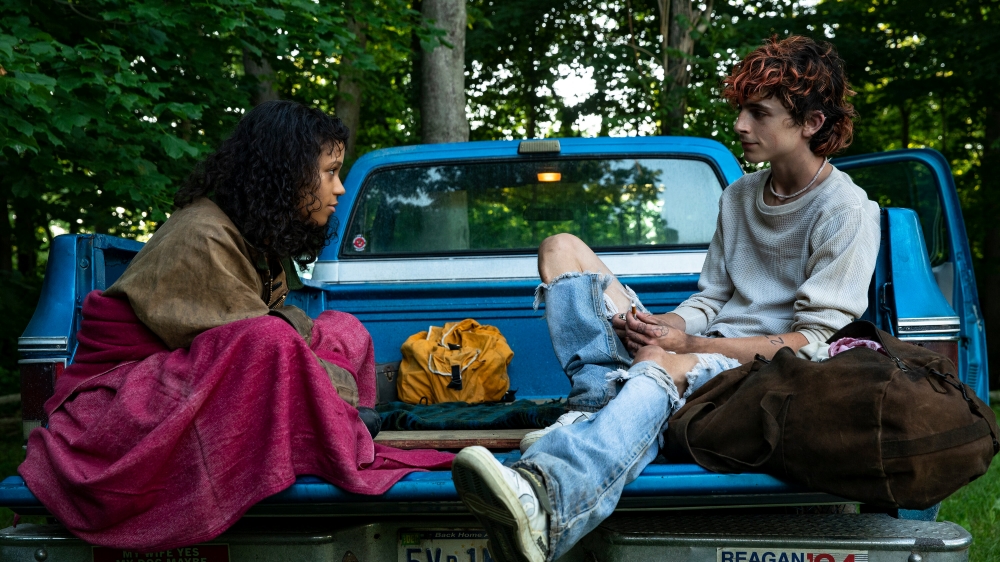
Maren and Li are not like that yet. They can cry, regret, yearn, be happy, and finally, love. They love each other, they love their family, they want to be good, they want to behave morally. But this is not a superhero story, it is not a story about the ultimate good that always prevails. It is a story where there are only losers because sometimes nature is a prison from which you cannot escape.
On the artistic side of things, it is no coincidence that the film won the Venice Film Festival’s award for Best Director. Luca Guadagnino seems to have used impressionism to fulfill the artistic idea of the film, as the first shots show impressionistic paintings that set the tone for the rest of the film. The director uses music, framing, and landscapes, like a painter, to paint the mood of the film with soft impressionistic strokes. Because in Impressionism, it is the impression that is the most important thing that a work of art evokes, the most important thing is the feeling. Through this contrast – of soft colors, such as the treeless roads, the meadows, the sun reflected on young faces, and dark colors, such as the fresh blood of the abra, the swarms of flies flying around the carrion – the director fulfills the artistic conception of the film.
The second trailer for the movie:
The soundtrack is worthy of special mention as it was composed by Trent Reznor and Atticus Rosas, especially for the film. Guadangnino said he wanted a melancholic soundtrack that would express eternal longing and reflect the landscape. The soundtrack features titles such as “(You Made It Feel) Like Home”, “You Don’t Have to Be Alone” and “We Should Feel Something”. Both the music itself and the song titles, as the director wanted, express an insatiable longing for human warmth and freedom. Eaters are always on the move, homeless, imprisoned by their nature, but freed by the unrestricted freedom of movement, eternally homeless. Does the monster have a heart? Maybe he had it in his youth but stabbed it himself? Stabbed by others? This film is a lot about cannibal hearts. In the end, it is a love story, as horrible as life itself.
Gorillaz: a music band combining animation
“Gorillaz” formed as a truly unique musical band in 1998 in London, combining a few musicians with animated characters. Its creator and lead members are musician Damon Albarn and artist Jamie Hewlett. Many other talented musicians join Albarn, and the animated characters serve as the imaginary members of the band.”Gorillaz” earns recognition for its innovative music, distinctive style, and exceptional visual presentation.
Animated characters assume the roles of band members as their personas in the band. The main characters are 2D, vocalist and keyboardist; Murdoc, bass guitarist; Noodle, guitarist; and Rass, drummer. Their performance reflects each of their unique characteristics and qualities. These attributes go beyond the confines of the musical arena, extending their influence to the various media projects in which Gorillaz is involved.
The band’s unique music blends a complex mix of different genres, encompassing alternative rock, electronic music, hip-hop, and various others. Their debut album, “Gorillaz,” was released in 2001 and achieved significant success. Notably, this album featured hits like “Clint Eastwood,” “19-2000,” and “Tomorrow Comes Today,” which ultimately came to symbolize the band’s distinctive style.
The first “Gorillaz” album was certified double platinum. With that achievement, the band set a new Guinness World Record for the most successful “Virtual Band.”
Aside from their music, the band is celebrated for their innovative approaches to presenting their work. “Gorillaz” often incorporates animations and video clips to enhance their music, offering it an added layer of context.”Animations enable them to create a unique world in which the band’s characters inhabit, allowing the band members to express themselves individually.
Their second album, “Demon Days” (2005), went six times platinum and features a wide range of musical styles, including rock, electronic music, hip-hop, alternative, and more. During the time of its release, this album emerged when pop music was facing intense critical scrutiny. It was then that “Gorillaz” gained recognition as a creative and rejuvenating force in the music industry.
“Demon Days” Album’s Impact and Design:
The album “Demon Days” is famous for it’s successful songs such as “Feel Good Inc.,”, “DARE” and “Dirty Harry”. Those singles became huge hits and helped the album secure a high position in the international music charts.
One of the most remarkable features of “Demon Days” is the album’s topic. It tells a story about a world plagued by various catastrophes and problems, including war, downtime, and global disasters. Those topics subtly permeate the whole album and give it a deep meaning, while at the same time encouraging listeners to think about the state of the world and the solutions to the problems.
The captivating album design of “Demon Days,” featuring animated characters crafted by Jamie Hewlett to represent the members of Gorillaz, takes center stage in various music videos. All of these elements work in harmony to create a unique atmosphere and elevate the visual expression of the album.
Spectacular Live Performances:
Gorillaz have earned a reputation for their distinctive and spectacular live performances. They give a unique look to their concerts with outstanding visual effects. The band frequently invites and collaborates with other famous musicians and artists, such as Snoop Dogg, De La Soul, Bobby Womack, Lou Reed, and many others.
Social engagement and political preferences:
Beyond their musical endeavors, Gorillaz actively participate in social activities. They consistently articulate their views on contemporary social and political issues through their song lyrics and social media. Additionally, the band has initiated numerous charity events and campaigns to support organizations and tackle social and environmental challenges. Their songs frequently convey political messages and reflect global issues.
Advertising and tradeline:
Gorillaz demonstrates commercial potential. They have collaborated with various trademarks and developed many trade lines. These include clothing, accessories, comic books, special editions of music releases, and much more. The band also participated in various commercial ventures, including car advertisements.
TV shows and movies:
Gorillaz have produced numerous TV shows and movies. In 2001, they released “Gorillaz: Phase One: Celebrity Take Down” as a DVD set, featuring a documentary on the band’s formation, music videos, and animations. In 2006, they showed a special illustrated movie called “Gorillaz: Phase Two—Slowboat to Hades.” Also, Gorillaz had their very own TV show called ‘Gorillaz: Reject False Icons.’
After their first successful album, Gorillaz released several more albums. These include “Plastic Beach” (2010), “The Fall” (2010), “Humanz” (2017), “The Now Now” (2018), “Song Machine” (2020), and their most recent one, “Cracker Island” (2023).
Horror for the Saints – Elvira, Mistress of the Dark
Elvira, the Mistress of the Dark, is a well-known icon of sexuality and horror from the last century, appearing in 1981 on the Los Angeles local TV show Elvira’s Movie Macabre. Witty, raunchy, sexy – viewers recognise her from her high hairstyle, long, tight, revealing dress and big… eyes. Indeed, Elvira doesn’t even need eyes between her nose and her forehead, because the others, staring out of the neckline of her dress, attract so much attention that the rest of the look seems superfluous. But that was the original idea – to create an attractive diva for America’s favourite children’s holiday.
Elvira actually started her career as a horror presenter. A local Los Angeles channel was looking for a replacement for deceased host Killer Seymour for its weekly horror show, Horror Show Fright Night. They were looking for someone fresh and sexy, namely a female character, and it just so happened that they liked the ironic, California-style girl. It was Elvira, played by Cassandra Peterson.

Elvira’s look was not without inspiration. It was films that inspired Cassandra Peterson to create the Elvira we know. The actress’s make-up artist suggested taking inspiration from Sharon Tate, the protagonist of Roman Polanski’s 1967 film The Fearless Vampire Killers (hence the high hairstyle), and Mortitia Addams, who exudes a creepy sexiness. And so, Elvira was born, without a name, without an origin, becoming a ruler of darkness for whom space-time is not so important. After all, forty years into the character’s existence, Elvira is still known and remembered, at least in America or among those Lithuanians who grew up in the 1990s.

How else could we describe Elvira? We have already said that she is ironic and a sex symbol in popular culture, waving her big, innocent eyes that shine like the signs of Las Vegas itself, where it all began. Indeed, Elvira has no sense of shame and climbs on every good-looking man she meets. She doesn’t really cringe if a good-looking man pushes her away. And I wouldn’t say she has no self-esteem, because she knows how to deal with men who harass her – Elvira knows her worth. She doesn’t worry too much if her looks make people prejudiced. She is basically friendly, talkative, cheerful and even, you could say, generous at times (though never without self-interest). There are even, I would say, instances of naivety. Maybe that is why she is so funny. So unpolished that, apart from her big ‘’eyes’’, she would resemble a roadside plevea, so childish, so full of her own primitive instincts, that without joking about intimate parts, you would say that she is a five-year-old crazy girl. This contrast makes her interesting to look at.

Now Elvira is a real brand. Cassandra Peterson, when asked if she was tired of playing the same character for so many years, said: “Definitely not! Have you lost your mind?” That’s because she owns all the copyrights. Every penny from Elvira’s brand goes to the actress. You can even find Elvira’s still-operating online shop, which sells T-shirts, mugs, badges, magnets, phone pads and even men’s shorts with Elvira’s merchandise. On Halloween, Elvira’s costume is one of the most popular among children in America. Cassandra Peterson has starred in countless television productions, books, comics, video games and even calendars. She has gone from earning $300 a week to making millions from the character she created.
And yet, this success is not only Elvira’s, but also Cassandra Peterson’s, for whom the character is a perfect fit. Although in reality she is a reserved woman, Cassandra, when she is Elvira, is simply crazy. She can chatter and joke endlessly. She can also dance and sing. That’s because she used to be a drag queen at the Purple Cow bar in Colorado Springs in her youth, performing with other drag queens there. That’s probably where she learned her expressiveness. As the actress herself says, she was brought up by a bunch of crazy drag queens. It was this experience that eventually led Cassandra Peterson to Las Vegas. She was only seventeen years old at the time.
It was in Las Vegas that she met the King of Rock ‘n’ Roll himself, Elvis Presley, who advised her, “If you really want to be in the entertainment business, you have to get out of this city. You just sang with me and I hear you have a beautiful voice. You should start singing. When you are 24 or 25, you will be too old to dance. You have to take a different path if you want to stay in the entertainment business.” So, Cassandra packed her things and headed for Hollywood.
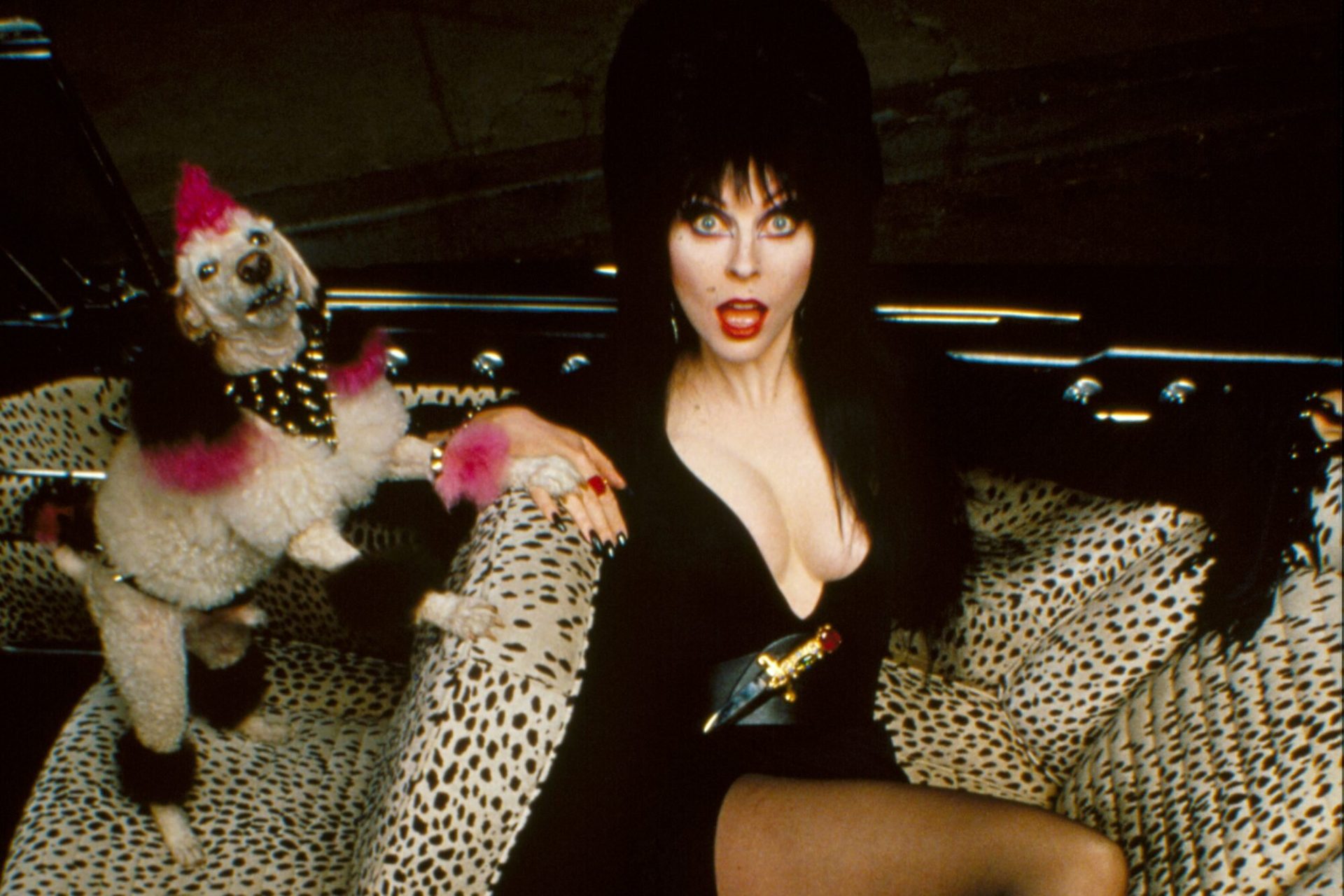
In 1988, the first Elvira film, Elvira: The Mistress of the Dark, was released. Cassandra Paterson had a few other film roles before that, but from 1988 onwards, her main work became playing Elvira. Elvira: The Mistress of the Dark is a horror comedy that continues the story of Elvira. While working as a host of a horror show, she receives a letter saying that she has inherited a fortune from her unknown aunt. And because Elvira doesn’t like her job (she eventually quits) and needs the money, the Mistress of the Dark is drawn to the small Massachusetts town of Farwell to claim her share of the inheritance. As it happens, all the older people in the town are the exact opposite of Elvira, i.e. embodiments of holiness, who are very concerned about morality, and of course the saints, when they see Elvira, immediately condemn her and try to get her out of town. But Elvira can’t leave yet because she has to sell her aunt’s house. In the meantime, she befriends the young people of the neighbourhood and an innocent young handsome boy, Bobby, whom she tries to seduce. Moreover, she makes an enemy, her witch uncle Vincent Talbot, who is not a very nice man. Elvira needs to find her witch nature and defeat her evil uncle.

The next film about Elvira was made more than a decade later, in 2001. It is called Elvira’s Haunted Hills. This film has no continuity with the first one – the time, the place, the plot are almost completely different. Cassandra Peterson and her then-husband and manager Mark Pierson spent three years trying to get funding from Hollywood, but finally decided to go it alone. They filmed in Romania and spent less than a million dollars.

This film is set in mid-19th century Romania. Elvira travels to Paris with her maid Zuzu to perform a unique show that will open Elvira’s door to the world of entertainment. However, they have no money at all, so they don’t mind when a carriage pulls up to take them. On board is an attractive young man who turns out to be a psychiatrist working for a local count. According to the doctor, the Count would be happy to give the young ladies a place to stay. Elvira, of course, is neither shy nor too young to make a big break. So, although she hides her enthusiasm, she accepts the offer. And then the whole thing boils over. It turns out that the Count had a wife who committed suicide ten years ago, and that wife, as if on purpose, resembles Elvira like two drops of water, so that the Count almost has an apoplectic fit when he sees the guest for the first time. And the rest of the castle’s inhabitants scream like mad when they see Elvira. The trouble doesn’t end there. It turns out that the entire Helsub family is under a spell, which sometimes causes them to go off the roof and behave strangely or have strange health problems. Elvira, as always, remains in good spirits and never stops joking, but eventually she has to face a real madhouse to escape the castle.
These films were followed by more productions about Elvira, but they were not very successful. Cassandra Peterson recently turned 70. She divorced her husband Mark Pierson in 2003 with whom she raised a daughter. However, some time ago, the actress announced that she had been living with a woman for nineteen years. She says that she has been hiding this fact all this time because she was afraid that Elvira’s fans might take it negatively and stop being interested in the actress. Cassandra thought that if it came out that the actress who plays the sex bomb and the seducer of men was in fact homosexual, the audience might not understand it. For the same reason, she also did not make her marriage to her ex-husband too public. However, in an interview, Cassandra says that she is now happy to have revealed the truth, because secrets make life difficult.
Elvira has become an iconic figure in American popular culture. And no wonder, because she emerged out of contemporary American culture, where Halloween is one of the most popular festivals and sexuality is like a label that marks Hollywood. Elvira is also the image of a strong, independent, modern woman who is pursuing a career and does not need anyone’s protection. And for the audience, she is entertainment fit for a late Halloween night.
“Stutz”, the Netflix film that became an open and sensitive therapy session
Jonah Hill is a 38-year-old actor who has appeared in films such as The Wolf of Wall Street and Don’t Look Up. The actor turned filmmaker has created a highly sensitive and honest candid documentary about his psychiatrist Phil Stutz, who not only shares techniques and tips for improving emotional health, but also opens up about the challenges he faces.
Phil Stutz is a 73-year-old psychotherapist. The doctor is known for several books he has written and has helped many Hollywood stars and celebrities, including Jonah Hill, with their psychological health. Stutz has developed many new techniques to help overcome psychological problems – the “shadow”, the ” string of pearls”, the ” grateful flow” and others, which are also revealed in this film. He also has a unique way of connecting with his patients. He is not just an observer who listens or encourages his clients to talk, but with humour and a variety of effective tools and visualisation exercises, he helps them to overcome difficulties.
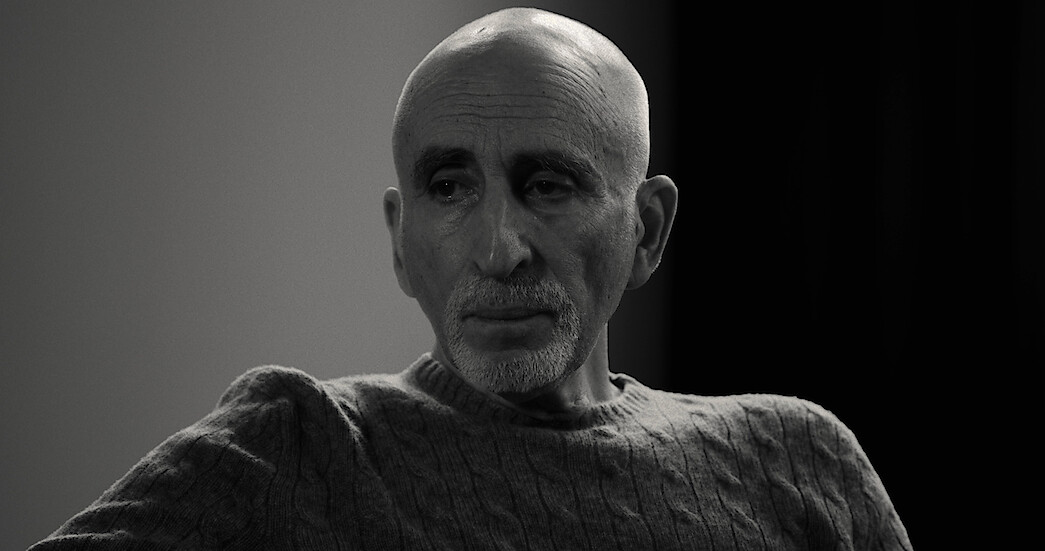
Actor Jonah Hill has been seeing a psychotherapist for five years. However, in this Netflix film, the roles are reversed as the psychotherapist opens up about his traumas and shares the techniques that help him too. The actor says that the doctor has helped him a lot over the past years and “changed his life”, so he wanted to share his advice with others.
During the interviews, Hill asks his psychotherapist about his life. The psychotherapist’s childhood was not easy: Stutz lost his younger brother of three years when he was still young. He grew up with an abusive father and a withdrawn mother. Stutz is presented as a man who always seemed to attract people who wanted to tell him about their problems. The loss of his brother, which shocked his family, led him to listen to the difficulties of his parents and relatives at the age of 10, which inspired him to become a psychotherapist. Stutz was later diagnosed with Parkinson’s disease, but this does not stop him from continuing his work and helping people.
The film also reveals that the doctors who help their clients are going through the same problems. Even Stutz, who has developed many different methods to help with psychological difficulties and helps others with their mental health on a daily basis, still finds himself dealing with negative thoughts about his brother’s death, his parents’ divorce and Parkinson’s disease.
“It’s important to realise that the people we look up to are not immune to the problems we are going through,” said the director about the meaning of the film.

The documentary had to look as if it were one continuous conversation, one coherent therapy session in a typical psychologist’s office. But Jonah Hill shatters this artificial illusion by revealing that the documentary is filmed over a period of two years, and that the setting is a film studio with a green screen. The actor is open with the audience, and in this moment of openness he also reveals the main message of the film: it is impossible to overcome psychological difficulties without being sincere and honest.
Despite the fact that the psychotherapist is in the spotlight, the actor Jonah Hill also opens up – he talks about panic attacks, complexes, his lack of confidence about his weight. He talks about how the death of his older brother, music producer Jordan Feldstein, compounded all this. Stutz, a psychotherapist, helps the actor to overcome these problems by sharing his advice, which is useful for anyone looking for answers: both the actor and the audience watching the film. The visualisations, drawn by the psychotherapist himself, help to bring these ideas to life even better.
Both Jonah Hill and Phil Stutz are very open in this documentary, which deals with themes of loss, love and self-doubt. The film reveals the bond between therapist and client, which develops into a close friendship, and this film only brings them closer together. This is an intimate and sincere psychological therapy session that everyone will benefit from.
The exceptional and charming Semmi Djabrail aims to change the way we look at people with disabilities
In 2017, Semmi Djabrail, a resident of St Petersburg, had a terrible accident that changed her life: she lost her right leg, fell into a coma and suffered multiple injuries. She had always dreamed of moving to the US, hoping that a career would await her in New York, but life was a cruel twist and she stayed in Russia to change people’s attitudes towards people with disabilities. Today, with 179,000 followers on Instagram, she inspires not only with her stunning photoshoots, but also with the texts she shares and her attitude towards life.
Semmi Djabrail was born in the Caucasus, went to university at the age of 15 and decided to move to St Petersburg. Here, she worked in a small private bar, which became like a second home, tried to climb the ladder of her modelling career, was active in sports and started her own Instagram blog. However, she did not hide that such a comfort zone has always been oppressive.
View this post on Instagram
“I wanted to improve, but when I came here I realised that St Petersburg is also a city of dead ambitions. It’s hard to make it here, people often don’t find themselves here, so I wanted to go to the US.” She wanted to make dolls and have a small, cosy private workshop. “Just before the car accident, everything was planned and I was already welcomed in New York.”
View this post on Instagram
In early autumn 2017, a car carrying Semmi and a friend crashed into a safety barrier between St Petersburg and Vyborg. “After the impact, I came to my senses and told my friend that I couldn’t move. I could hardly see anything, everything in front of my eyes was very faint. My spine, my ribs, my pelvis, one leg was broken and the other was torn off, but I hardly felt any pain.
View this post on Instagram
“I had to wait a very long time for an ambulance and I will never forget it, because life seemed to flow out of me in a war with blood. I didn’t feel my body at all, but I just tried not to die because I still thought I hadn’t done that much. I had all sorts of thoughts: Damn, am I really dying? Really? Already? A man came running up, gently slapping my cheeks and demanding me not to close my eyes, and by the time the ambulance arrived, we were both nearly dead, had waited a long time and lost a lot of blood. The doctors started cutting my clothes at lightning speed and I even tried to stop them. I was wearing a worn men’s T-shirt and a sweatshirt given to me by a friend, which I really liked.” – said the girl.
View this post on Instagram
Five major operations were carried out in the hospital, one lasting ten hours. Semmi’s right leg was amputated, she suffered multiple injuries and was in a coma for six days. “When I woke up, I thought it had only been three hours, but it had been six days.” “I was so dizzy from the high dose of medication that I told the nurses I had fallen off a cliff and was among some naked people. I realise now that they listen to such nonsense on a regular basis, but at the time I really believed it.” “As I looked under the blanket, I mentally prayed that they had sewn it on. But unfortunately, my leg was not there.”
View this post on Instagram
“I was in hospital for a month and a half. Crowds of acquaintances came, and the room was bursting with flowers and gifts. I didn’t expect it. Yes, I was surrounded by good people and it was wonderful. But am I really worth it? In fact, I don’t think there is anything in me right now that needs to be loved. I always felt like I needed to earn a good attitude.”
View this post on Instagram
“I decided that if all I think about is how bad things are with me and how I am somehow different, bad, horrible, ugly without my leg, then my life will only get worse. Why hurt yourself? Why bother thinking about things that cannot be changed? I have had appointments with psychologists and psychotherapists, but each time I felt bored and tired. Therefore, I am my own doctor in this matter. Now I have clarity in my head, I often talk about it without pain, and that’s what keeps me going.”
View this post on Instagram
A year after the accident, Semmi decided to have a prosthetic leg. She raised money for it, with the help of family, friends and even Instagram followers. The cost of the prosthesis was a hefty 4 million roubles (61 000 USD). Two months after her successful prosthetic leg, Semmi posted her first photo with her new prosthetic leg and received many nice messages and support.
“After the accident, I became even more aware of how far behind the West we are in terms of our attitude towards people with disabilities. I don’t like the word ‘disabled’, even though we have it in our vocabulary. I am a full-fledged girl, I have everything. But my grandmothers are very sorry for me, they want to give me money. For example, I am well dressed, I am in a wheelchair, I am waiting for a car with a friend, and they give me coins. All I have to do is ask them with my eyes puffed out, “Grandma, what are you doing?”
View this post on Instagram
“One of my main goals is to try to change this attitude. I don’t want to be seen as just a disabled person. I need people to understand that different doesn’t mean ‘bad’ or ‘scary’. This xenophobia slows down our society, people are afraid of everything. Nobody limits me – even though I have a prosthetic leg. I don’t need to feel sorry for myself: I sleep, socialise, eat, do my own thing, and live, just like everyone else. I don’t think all day: ‘Oh, how can I live without a leg’.
View this post on Instagram
I now have several projects aimed at changing the paradigm of how people with disabilities are perceived. Filmmaking and interviewing is not a matter of vanity and ambition, I want to help those who are in a similar situation. They, like me, should not feel uncomfortable just because they are different from others. Now I have Instagram to help me, and without advertising anything, just being honest about my experiences and what happened, I got a lot of attention from the environment. And now I can also contribute by raising funds myself, by donating to help people who have been through similar events.” The girl continues to take part in photo shoots, and writes a blog and her Instagram account is growing daily.
“No Hard Feelings” – J. Lawrence’s comedy hit
“No Hard Feelings,” directed by Gene Stupnitsky, is a breezy, irreverent N16 comedy that’s sure to tickle the funny bone of comedy enthusiasts and beyond.
The film’s protagonist, Maddie (Jennifer Lawrence), a carefree, non-committal Uber driver and bartender at a local bar, ends up not only losing her car, one of her main sources of income, due to debt, but also the house she has inherited from her mother, which is crucial for her to keep.
Living in the resort town of Montauk, New York, she strongly criticizes wealthy people who come to spend their summers in her hometown and raise the land tax. Looking for a quick and cheap way to get a car to work so she can keep her house, she stumbles across an online ad in which wealthy parents Alison (Laura Benatti) and Laird (Matthew Broderick) are looking for a girl who can help their shut-in, introverted, self-conscious son Percy (Andrew Barth Feldman), who is about to leave in the autumn to study at Princeton University, to open up and build up his confidence.
In return, they give him a Buick Regal—not a new car, but a clean one. Unsure whether the advertisement is genuine, Maddie decides to give it a try, and, although she is a little older than Percy’s parents would like, she gets the job and takes it.
Jennifer Lawrence (Maddie) and Andrew Barth Feldman (Percy) in “No Hard Feelings” screencap. It is interesting to note that the director was inspired to make this film by a similar advertisement sent to him by a colleague four years ago. “I thought, what kind of people put up ads like that—those overprotective and over-interested helicopter parents who hire tutors for everything, even for such things? Then I thought, – who responds to such ads, and what is going on in her life?” – said the director during an interview with Sarah Bradbury from The Upcoming.
Actress Jennifer Lawrence, who got the leading part in the movie, played the role of Maddie flawlessly. This was not only due to her natural talent for acting and her range, but also to the fact that the role was written for her and was in the director’s mind from the very beginning.
Up until now, she has mostly appeared in more serious movies, and “No Hard Feelings” seemed to give her a way to move to a new level—the comedy genre—which suits her very well. “<…> She’s so funny in this movie that even though I’m quite biased, her performance for this film is one of my favorite performances of hers in general.”— praised the director.

Andrew Barth Feldman, who portrayed Percy, stood out from the beginning during auditions, and to confirm his suitability for the role, they assessed another 700 candidates. Stupnitsky believed he was perfect for the part due to a unique quality that caught his attention. The director’s primary concern was their ability to collaborate effectively, and in his view, their partnership proved to be seamless and highly successful, showcasing undeniable chemistry and an excellent match. This is also clearly visible in the movie itself.
“No Hard Feelings” is relatively short (1h 43 min), but it contains a lot. Many different ideas intertwine to form a single story. It portrays parents who are overprotective of their children and who interfere in their lives too much and too often, as well as the so-called Generation Z, who spend most of their time on their phones or on the internet, and it also emphasizes a certain generational difference, which is particularly evident in some of the film’s scenes.
The first part of it is very spontaneous, unpredictable, and comical, not only making you laugh and smile but also, at times, maybe cringe (not in a bad way), which leaves you wondering “Why would someone do that?”.
And the second half of the movie focuses more on self-reflection, on the emotional change and growth of the characters, and on the recognition of their mistakes and their decisions. The mood is mainly sentimental, but there are also elements of comedy in the first half. Throughout the film, there are also poignant and funny lines of dialogue and swearing. Visually, the film is also beautiful to look at, with a retro feel to it.

In the last few years, thrillers, action, horror, and fantasy movies have been the most popular genres in cinema, so when a comedy hits the screens, it can feel refreshing.
“No Hard Feelings” is a very summery, light-hearted movie designed to have a good time and a good laugh, so it is not too demanding and is perfect for just relaxing, not thinking, and having a good time.
Gene Stupnitsky is a Ukrainian-American director, probably best known for his movies “Good Boys”, “Bad Teacher”, and the TV series “The Office”, which he contributed to and even appeared in one episode.

